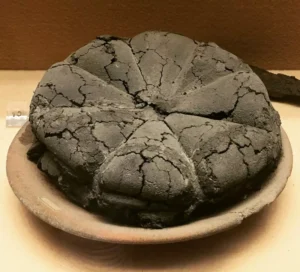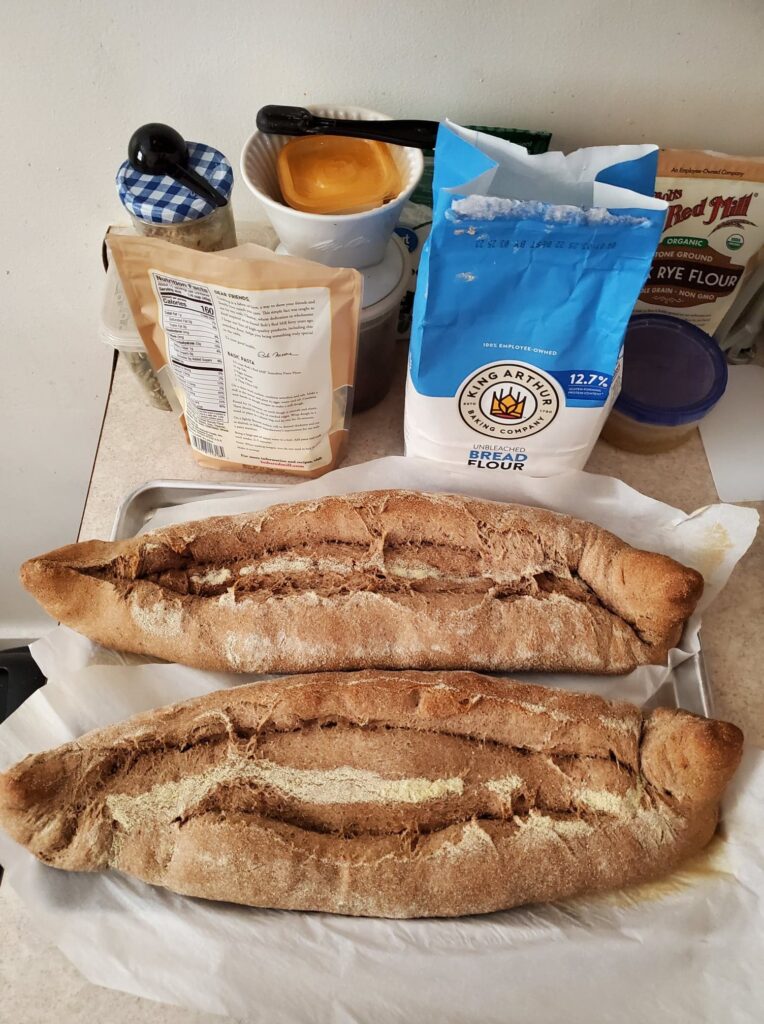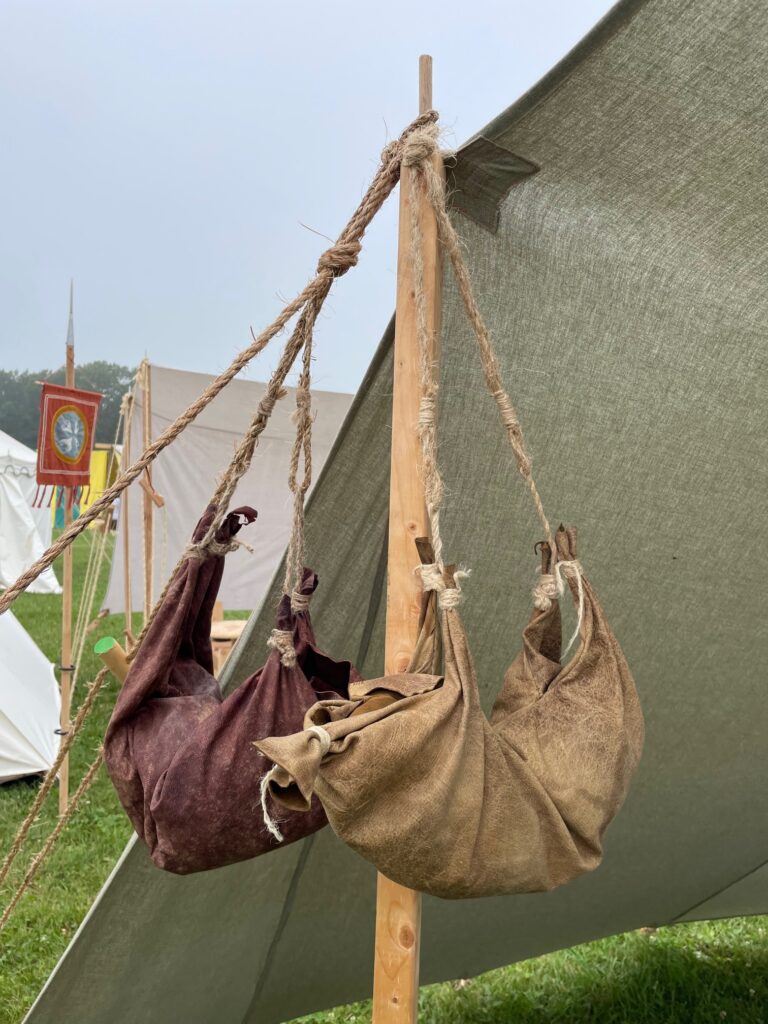In 2019, archaeologists in Pompeii discovered a remarkably well-preserved thermopolium, a hot food stand, essentially the fast-food restaurant of Roman times. These food stands were scattered throughout Pompeii, but the excellent preservation of this specimen made it both compelling to look at and gastronomically interesting because of the traces of preserved foods and the painted “menus” on the stand’s sides. The site opened to the public in 2021 and was featured in a number of news stories and history blogs.
While this isn’t my usual area of interest, I was enchanted by the idea of a hot food counter and, because I have that sort of friends, I quickly found some enthusiastic co-conspirators to produce a thermopolium for an evening event in July, 2022. Below are some details about the thermopolium, our attempts at recreation, recipes, and lessons learned.
The Pompeii Thermopolium
The thermopolium we are emulating was located in the Regio V section of Pompeii, behind a small square with a cistern, a fountain and water tower. The whole space of the restaurant has been excavated so we have a good feeling for the layout and what was served. The food was served from a long counter into which were sunk dolia – ceramic jugs that were used to store food and keep it warm. These dolia contain pieces of foodstuffs, including duck, pig, goat, fish, and snails and it is hoped that further analysis of the residues will provide more details about their contents, including possibly spices or other flavorings. The paintings along the counter seem to depict the menu of possible options – at the very least both wine and duck were both depicted and served and there is a dog painting and skeleton within the restaurant. Other food service items recovered from the site include amphorae, bronze patera, flasks, and other common ceramics. The official Pompeii site has additional information and many more images. All images of the original site on this website are courtesy the Archaeological Park of Pompeii.
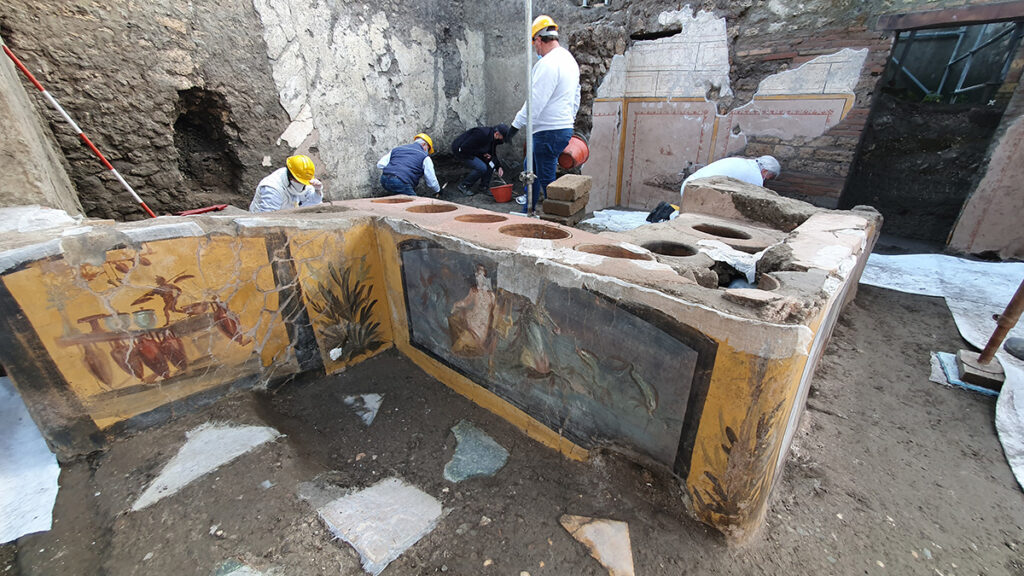
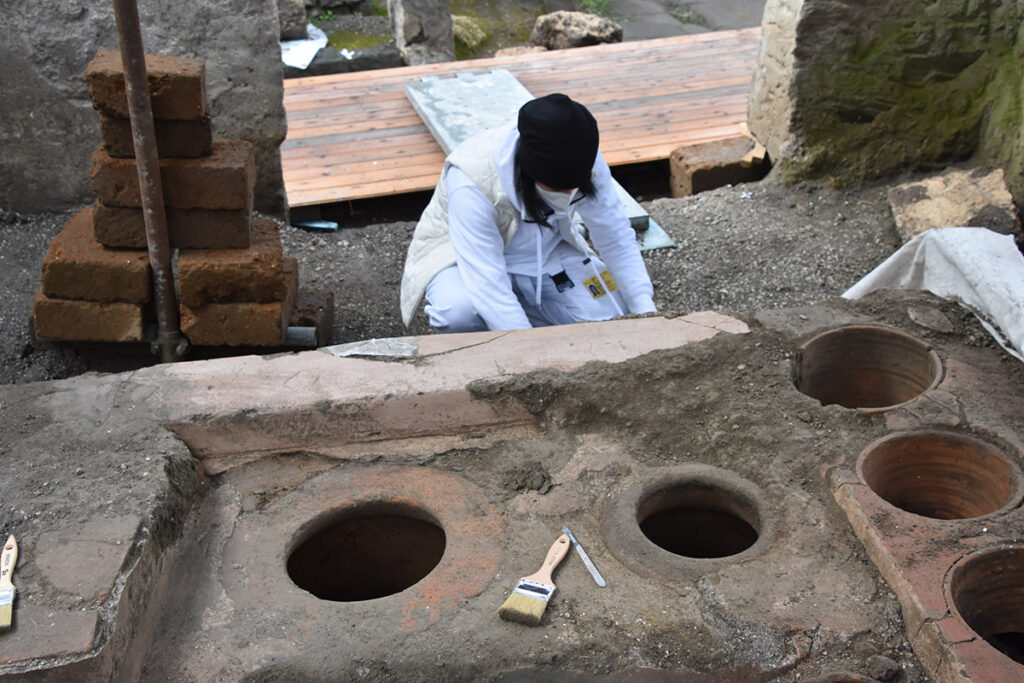

Thermopolia like this would have been important to Pompeiian life because the poor and middle classes generally did not have cooking facilities in their living quarters. The average person would eat our or get carry-out for most of their meals, often from taverns or thermopolia like this one.
Structure
The base of our thermopolium was designed and constructed by Hrothgar Ulf Gunnarsson, called Gar. The structure is supported on trestle tables of medieval design because the people of the middle ages were masters at breakdown furniture and these tables needed to be sturdy but also break down as flat as possible for transport and storage. The legs are a “sawhorse” type construction with two tripod leg constructs per table that support the top. One leg set is perpendicular and the third leg is canted at an angle to help provide stability. The inspiration for the construction is based on three articles, here, here, and here.
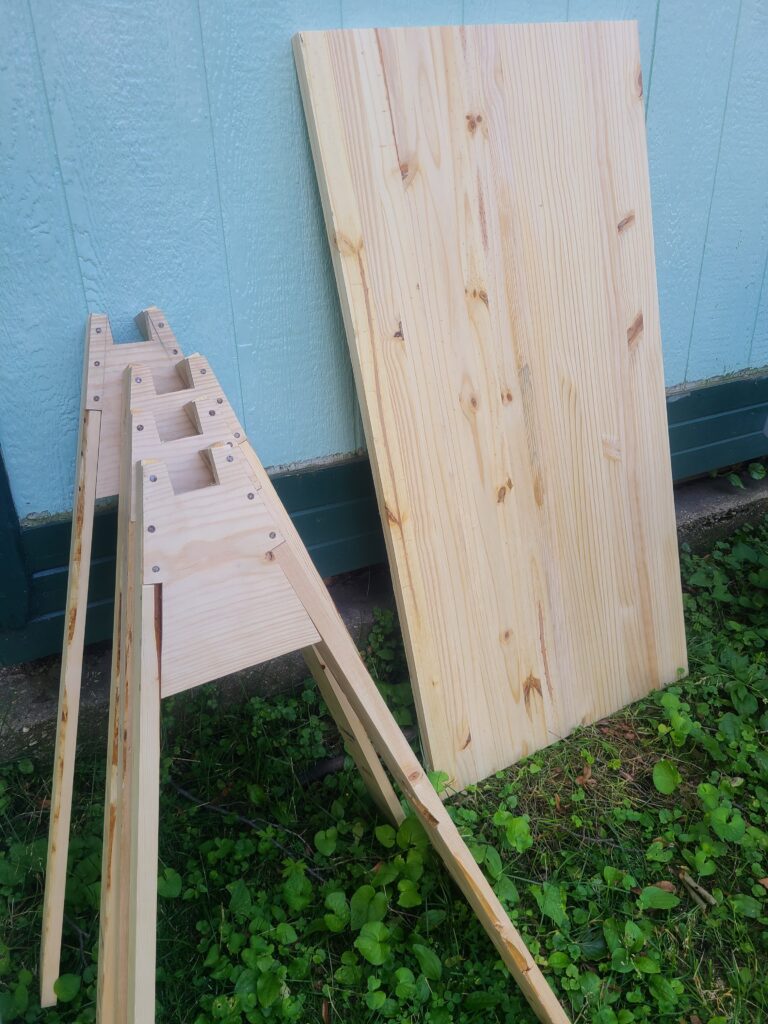
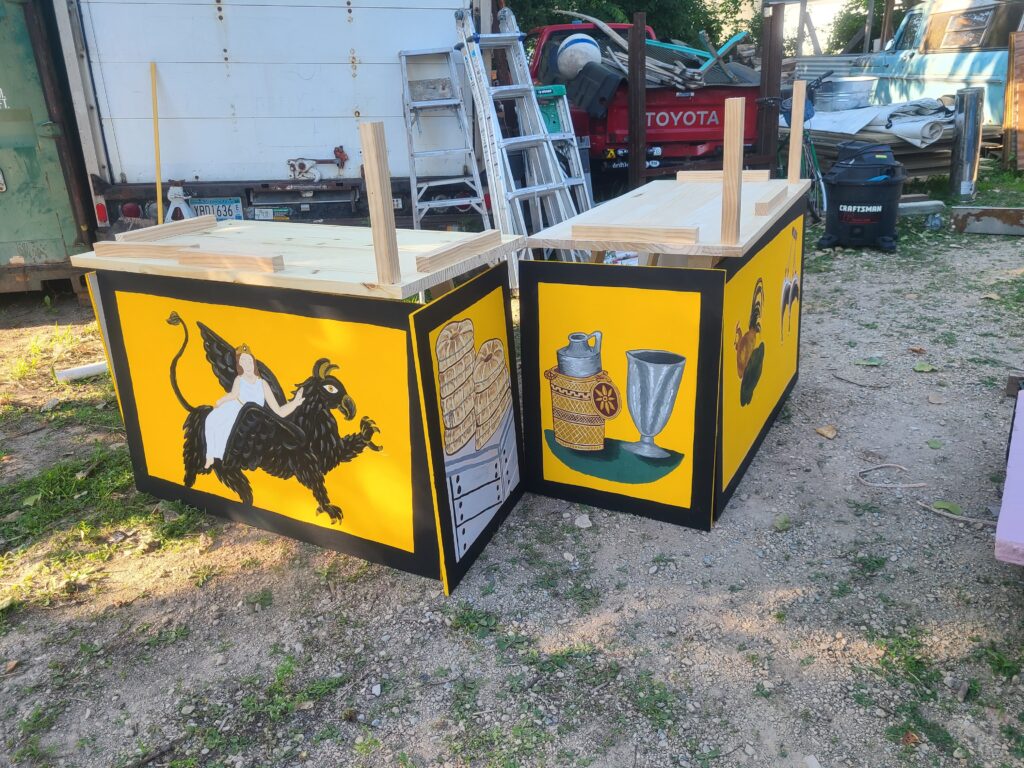
The original food stall found in Pompeii was constructed of concrete, which is not exactly portable, so we chose instead to make panels painted with “frescoes” to imitate the shape and decorative scheme of the original. The panels are half inch plywood, primed, painted with modified paintings in the style of the original frescoes from Pompeii (see details below), and then sealed with a modern poly sealant to protect the art and make for ease of cleaning.
The panels are attached to the table tops using nailer rails. Our version provides eight linear feet of total usable table surface. The original stall was significantly larger and we did add an undecorated “beverage station” to prevent crowding during serving. The original stall have built in heating ports that would have likely housed coals for keeping foods hot while in service. We will be using Nesco roasters and Crock Pots to simulate this for food safety reasons.
“Frescoes”
We wanted our thermopolium to be brightly decorated in the same general scheme as the original frescos. Conveniently, the Pompeii thermopolium featured a lot of bright yellow and black, the local group colors, so we adopted a yellow background with black frame as the unifying feature for our panels. Since we were creating a movable structure and not decorating plastered walls, we used acrylic paints on wood panels. Some images were transferred on the panels using a projector, but most were sketched on freehand in chalk.
The original main painting at the thermopolium was of a Nereid riding a sea-horse. We have changed it to be a Queen of Northshield riding a black and gold Griffon. (Painting by Eithni)

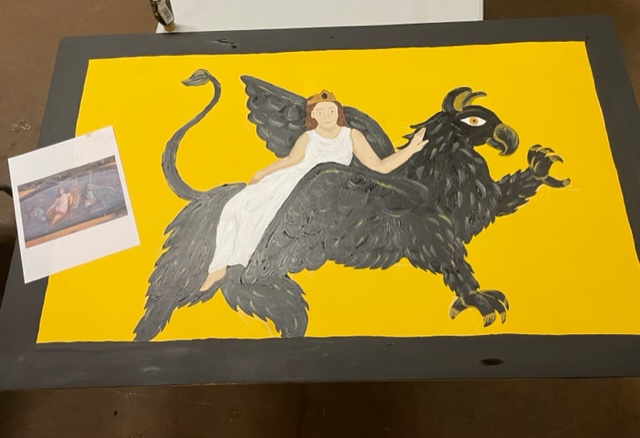

The other large panel depicts part of the thermopolium’s menu – Ducks and Chicken – and this image was largely reproduced as in the original, but with the right and left sides reversed. (Painting by Alissende)


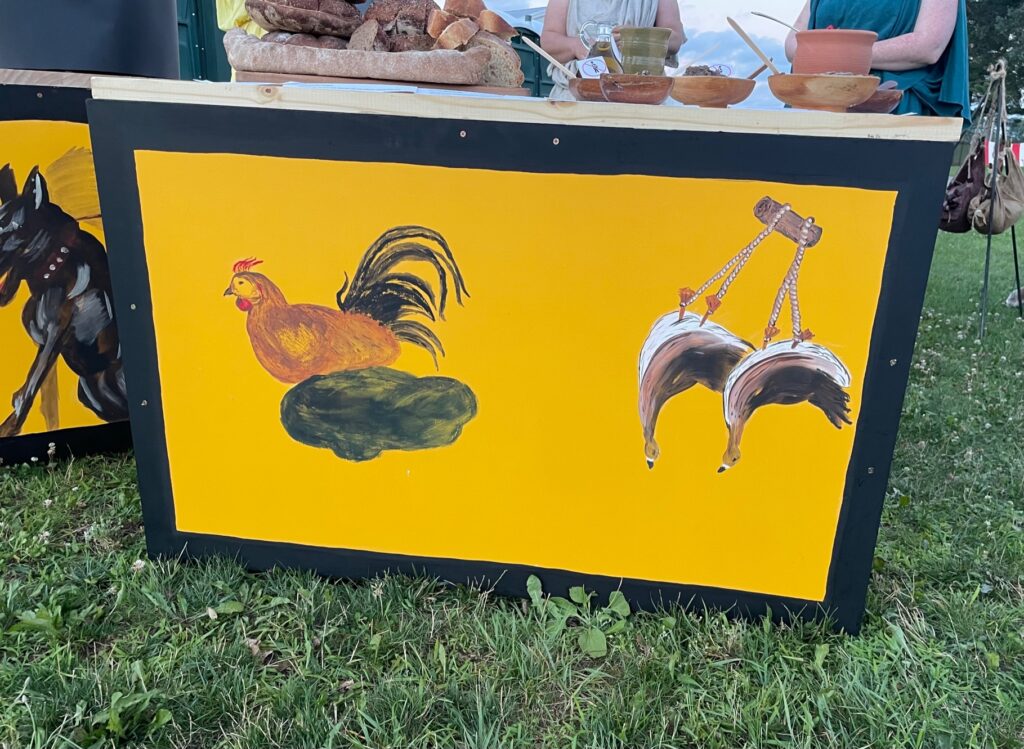
One of the more charming panels is a depiction of a dog tied up to the end of the counter. Is this a memorial to a beloved pet? A warning of a guard dog on premises? An advertising that is is a pet-friendly restaurant? The meaning is unclear, but we have included him in our food stand. (Painting by Gar)

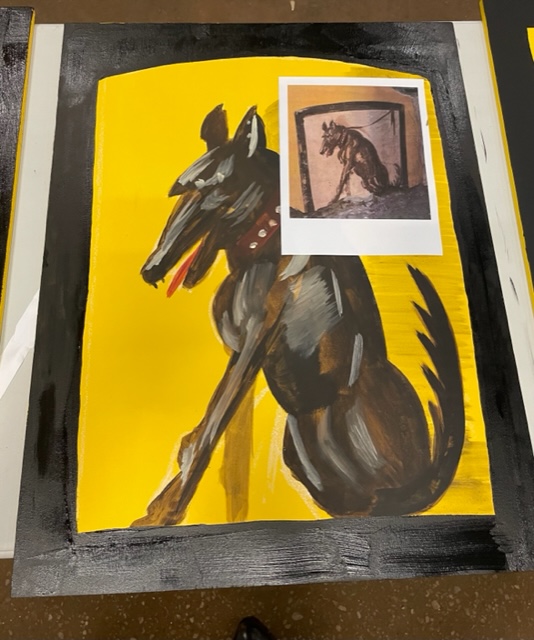
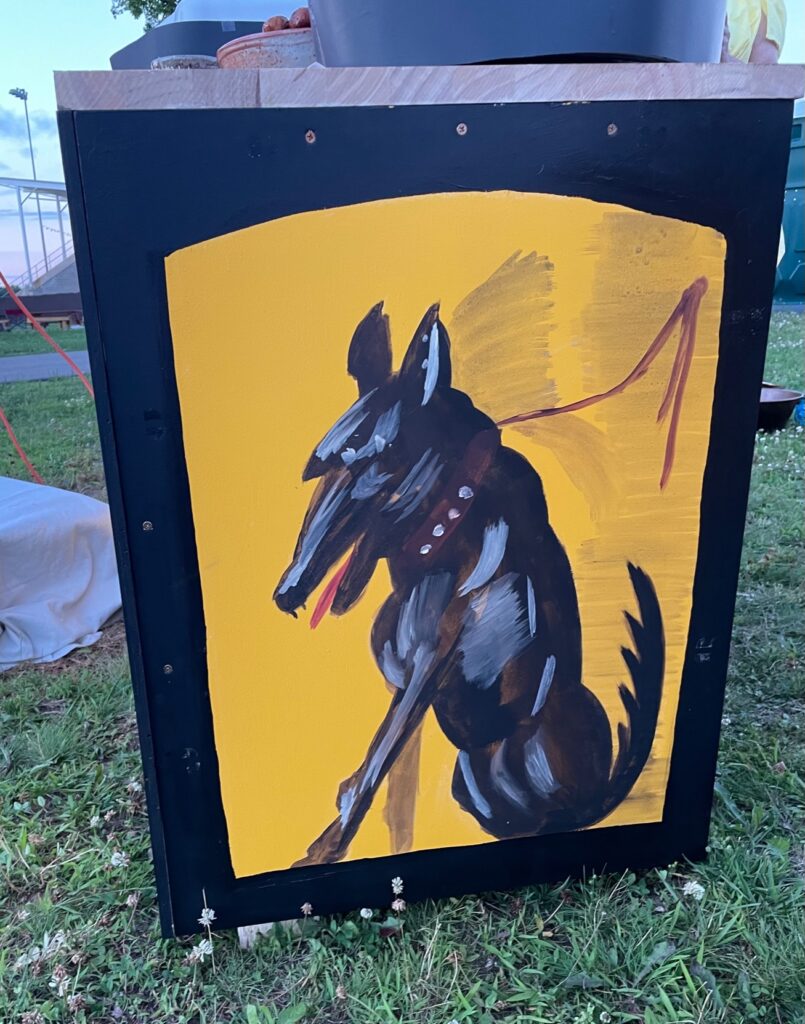
We wanted the images on our thermopolium to include a “menu” of our planned offerings, so we included some images from other sources, including some beverage containers to indicate posca, some amphorae to indicate wine, and some bread and beehives to indicate the bread that is served and the honey that is in many dishes. (Paintings by Bridei and Eithni)

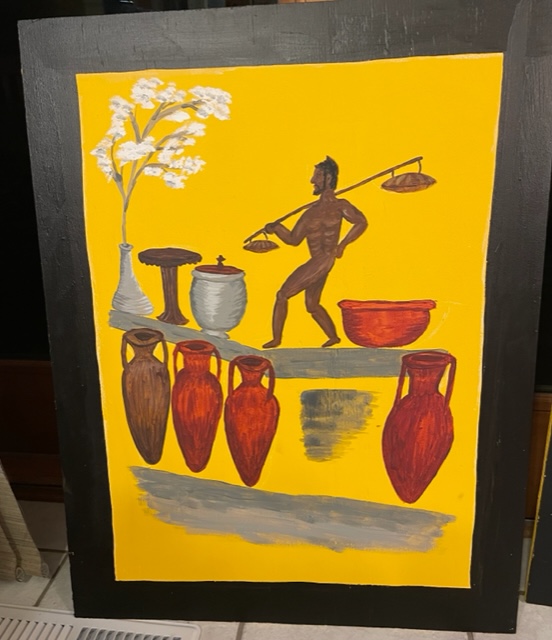
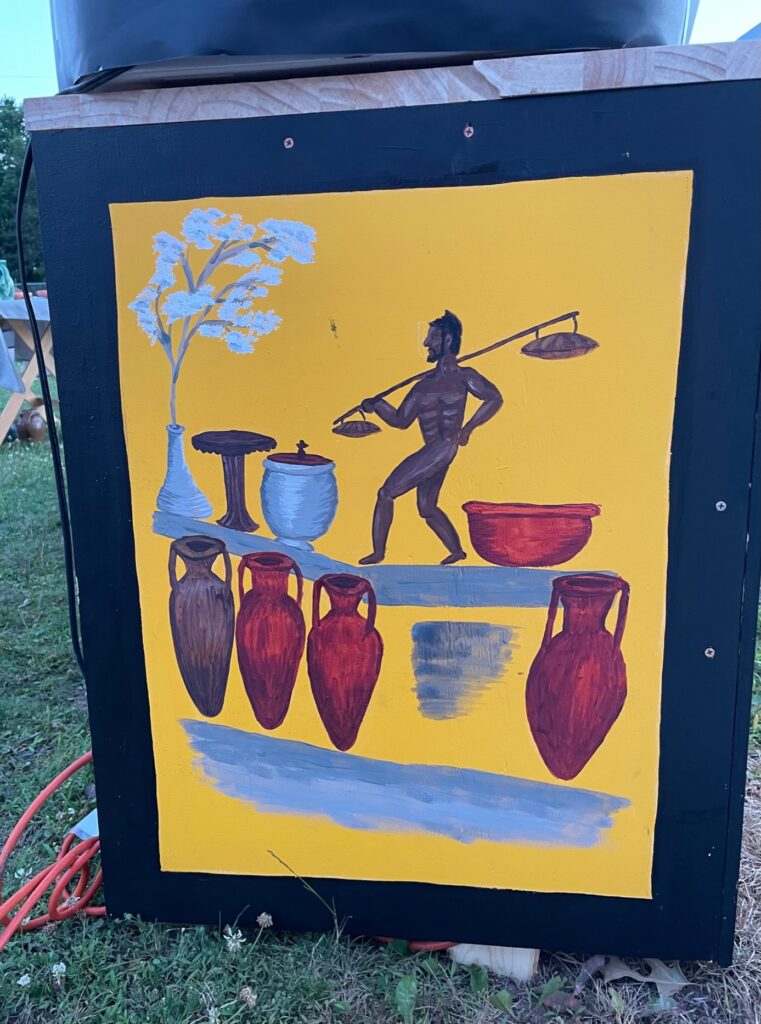



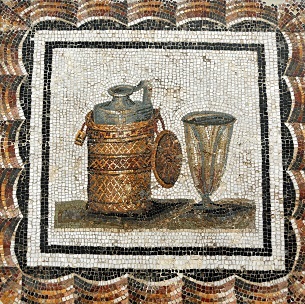
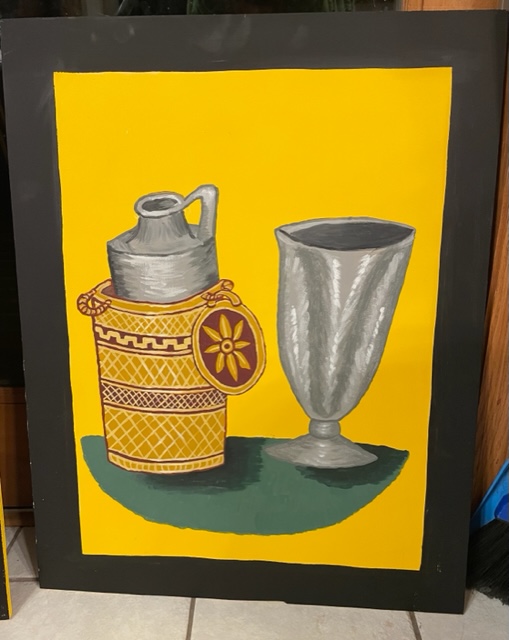

Pottery
The pottery used to serve the beverages was researched and produced by Farolfus filius Richardi.
Figure 1. Fresco depicting Vulcan and potter from the exterior of the south enclosure wall of the Officina Vasaria di Nicanor in Pompeii
(© Soprintendenza Archeologica di Pompei).
Figure 2. Detail from the Officina Vasaria di Nicanor fresco showing three finished vessels.
While we often think of handmade pottery as a precious thing today, this was not necessarily the case in ancient Rome. In addition to finely crafted decorative wares, large amphorae used for wine and oil, and lamps, potters produced countless common, utilitarian vessels for storage, packaging, cooking, and eating. One Pompeiian graffito scratched into a house wall lists household expenditures and indicates that a cooking pot or a plate had a value equivalent to half the cost of one day’s bread for a slave (Peña & McCallum, 2009). For this project, I wanted to make a pile of small inexpensive bowls that could be used for tasting portions of food. In looking at vessels that might fit the bill, I decided to start with a basic form that can be seen in one of the two Pompeiian frescoes that depict potters at work (Figure 1). In this image, found on the exterior wall of a building believed to have been a potter’s workspace and/or shop, a potter is shown seated at a low wheel in the process of making a small vessel while the god Vulcan, patron of potters, looks on (McCallum, 2009). On the ground next to him (see detail in Figure 2) are three small finished vessels: a jug, a bowl, and a beaker, each of which appear to be no more than several inches tall or wide. I found several extant examples of contemporary vessels in museum collections. The first is a small bowl from the collection of the Metropolitan Museum of Art (Figure 3) with a pronounced foot at the base, angled lower walls, and a slightly inverted rim.
Figure 3. 1st c. CE bowl from Pompeii. Metropolitan Museum of Art, 74.51.387.
Figure 4. Small bowl, c.50-75 CE, produced in the Bay of Naples. British Museum, 1856,1223.363.
A simpler example in the collection of the British Museum (Figure 4) has a small trimmed foot rather than the larger one found on the Met example. This would be better suited for an inexpensive vessel, since it eliminates the second step of adding the foot ring and allows the potter to make more bowls in the same amount of time. More exaggerated versions of this form were commonly used to hold pigments used for fresco painting (see Figure 5); the inverted rim makes a vessel slightly annoying to drink from but holds in the contents, making it ideal for something with sauces in it (or for subsequent repurposing to hold non-food items).
Figure 5. Small utilitarian bowls used to hold pigment; in storage at the Applied Research Laboratory, Pompeii https://twitter.com/pompeii_sites/status/924918434131070977/photo/1
The image of the pigment bowls shows that there was a fair amount of variation in size and proportion within the basic shape category, rather than a formalized shape. I ended up settling on a version that had an inverted rim, sloping walls, and an integral foot. Mine were thrown “off the hump”–a production technique that lets a potter center one large mass of clay, section off a small portion at the top, and work their way downward, cutting each finished vessel off the top as they go. The frescoes do not show this specific technique, but it fit the spirit of the task and is still used today in countries that retain a tradition of mass-producing wheel-thrown pottery. An online search will yield countless videos of potters in India preparing small clay lamps or diya for the Diwali festival, and scholars reference this as a comparison for Roman production methods (McCallum, 2009).
While the bowl in the Met appears to have a polished red terra sigillata surface, the others are of unburnished earthenware. I used a modern earthenware clay body that should provide a comparable level of porosity and feel. Like the historical examples, these are unglazed, so they should be cleaned promptly and not used to prepare raw meat or egg, but can be treated more or less like a terra cotta flowerpot.
Menu
Having created our restaurant and tablewear, we needed food to serve from our thermopolium! We used the information from the Pompeii thermopolium and finds from throughout Pompeii to guide some of our choices. Bread of several sorts was a necessity, as was wine (evidenced by the amphorae). The choice to include a duck and chicken dish was due to the images of ducks and chickens in the Pompeii themopolium. The find of bean meal at the bottom of a dolium used for serving wine resulted in interesting experiments, but was NOT served due to truly terrible results of the test samples (see notes under “white wine” below). Sol has offered taste testing of unusual flavors and sauces at previous events and graciously agreed to research and present some Roman sauces to compliment the breads and other offerings. Other choices were made to round out the menu – coriander lamb because it sounded delicious, carrot/parsnip and fava bean dishes to provide vegetables, minted melon for a cool refreshing option, and globis for a sweet finish. Read on for the details of our fast food menu!
Bread
Panis Quadratus (Eithni)
The first type of bread served is a Panis Quadratus – a bread reconstructed based on evidence from Pompeii. Because of the quick destruction of Pompeii and Herculaneum, there are actually several reasonably intact loaves of bread that survive. Several of them follow the same general format – medium sized loaves tied around with a cord and divided into four, eight, or more segments. It’s unclear what the twine was for – perhaps carrying the loaf, keeping it from spreading too far, or helping to sub-divide the loaf – or how exactly the segments were produced – impressions with a dowel, form or string – but it results in a characteristic shape of loaf.
I based the loaves on the recipe and instructions posted on Breadtopia, but several variations exist. To create the segments, I used a well-floured metal straw, pressed firmly and almost through the loaf before its final rise. The first loaf, below left, followed the directions and used King Arthur whole wheat flour which produced a flavorful loaf with an open crumb. The second loaf, middle below, used no seeds and Bob’s Red Mill stone ground whole wheat flour. This produced a chewier, denser loaf. Based on the feedback from taste-testers, the served loaves will either be plain for the seed-averse or with extra sesame and poppy seeds, plus additional seeds on top. The original amounts of nigella and anise seeds were deemed to be sufficient. Each recipe produced a loaf weighing a bit over 3 pounds.


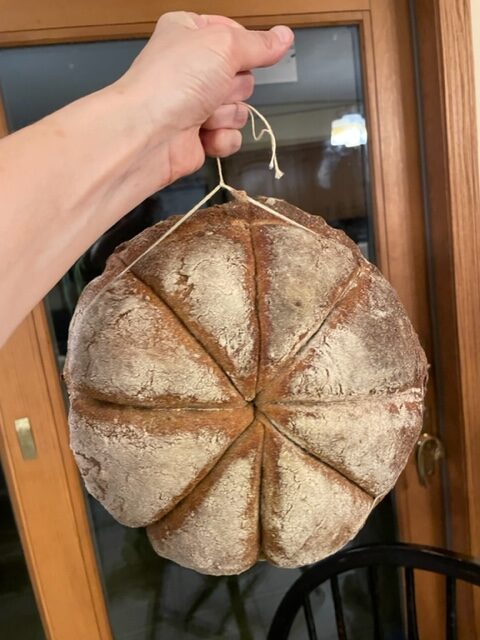
Trial number three was with North Dakota Mills flour and extra seeds, both in and on the loaf. I doubled the poppyseed and sesame seed amounts but kept the original amount of anise and nigella seeds as those were perceived as being the dominant tastes by the taste-testers. I also let it rise overnight instead of the suggested 4.5 hours for the long rise to see if I can get a lighter loaf. This is closest to what will be served at the event.
Ingredients:
- 5 cups whole wheat flour
- 2 tsp salt
- 6 Tbsp toasted sesame seeds (omitted in the seedless loaves)
- 2 tsp toasted nigella seeds (omitted in the seedless loaves)
- 2 tsp anise seeds (omitted in the seedless loaves)
- 4 tsp poppy seeds (omitted in the seedless loaves)
- 1.5-2 cups water
- 1 cup ripe sourdough starter
- 2 Tbsp honey (4 Tbsp sugar may be substituted to make this vegan)
Preparation:
Detailed directions at the Breadtopia link, but simply: Combine the dry ingredients in a large bowl. Combine the wet ingredients in a separate bowl, reserving some of the water. Pour the wets into the drys and mix. Add water or flour to make an elastic dough. Allow to rest 30 minutes. Knead. Allow to rest 30 minutes. Knead. Allow to rest until increased 75% – about 5 hours. Form into a smooth round loaf by tucking the bread underneath itself and place on a well floured surface. (Breadtopia suggests putting on a piece of parchment paper but that ended tragically with parchment paper stuck to the bottom – I had much better luck just transferring the floured loaves.) Allow to rest for 2-3 hours. Bake at 450 – ideally in a preheated Dutch oven or similar – 25 minutes with the lid on, 15 minutes with the lid off.
As with many ancient recipes, there are multiple versions available, since bread was often made and rarely was a recipe recorded. For another interpretation, see here.
Mustacei (Messiena Marcella)
Mustacei is a grape must bread, here being presented in the quadratis format. The description can be found in Marcus Porcius Cato’s De Agricultura as follows:
Mustaceos sic facito. Farinae siligineae modium unum musto conspargito. Anesum, cuminum, adipis P. II, casei libram, et de virga lauri deradito, eodem addito, et ubi definxeris, lauri folia subtus addito, cum coques. (Cato, 181.)
Prepare the mustacei this way. Pour must on a modicum of white wheat flour. Add anise, cumin, two pounds lard, one pound cheese. Pick bay laurel leaves and shape the bread the size of the leaves. Bake the bread on the bay laurel leaves.
The bread presented at the event does not contain lard so as to maintain it as vegetarian. The cheese is simple acid cheese made with cow’s whole milk. These loaves were baked on a sheet pan, which may have contributed to the loss of definition in the segmentation.
Ingredients:
- 600 grams unbleached bread flour
- 270 grams 3-day fermented green grape must
- Spring water
- 100 grams fresh cheese
- 50 grams shortening
- Anise seeds
- Ground cumin
- Salt
- Bay leaves
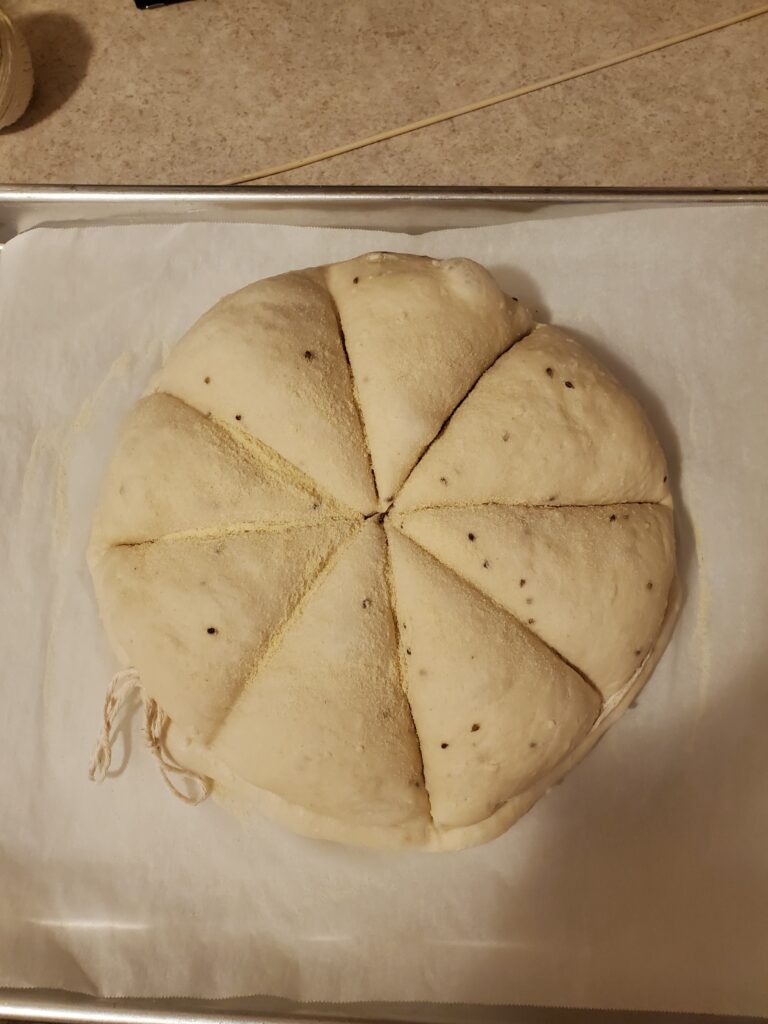

Demeter’s Daughter Trieme Bread (Messiena Marcella)
This bread is known as Demeter’s Daughter and is shaped like a Greek ship called a Trireme.
This translation came from the Loeb Classical Library edition of The Deipnosophistae of Athenaeus.
“The kneaded roll, Demeter’s Daughter, draws its hollow cleft along, made by the preasure of the fingers to look like a trireme’s ram. The best introduction to dinner.”
I learned about this bread from the blog Tavola Mediterranea, where Farrell Monaco has done the work along with her colleagues to start from the ancient text to decide what this passage from Athenaeus means. She and her friends deduced that it is supposed to be a kneaded bread shaped like a ship with a furrow down the middle.
The recipe I used is fairly simple.
Ingredients:
- 600 grams whole wheat flour
- 400 grams spring water
- 117 grams rye starter
- 8 grams salt
- 20 grams honey
- ground coriander seeds
- ground fennel seeds
- dried parsley
- dusting of semolina flour
This is a similar recipe as I would use for a whole wheat panis quadratis.
Roti (Purchased)
We also served some purchased whole wheat roti to use as “plates” or for trying the sauces as they are a good approximation of a generic whole wheat flat bread that would have been available in Pompeii (Grainger, 34-36).
Food
Duck and Chicken (Alissende)
Based on Apicius, Book VI “On Fowl” and various sauce recipes. Apicius 6.2.2 and 6.2.22 were particularly referenced as well as an article from Atlas Obscura.
Apicius’ instructions:
Wash and dress (the bird) and put in a large cooking pot; add water, salt, dill; cook it until it is firm, halfway through the cooking process; take it out and put it in another pan with oil and liquamen and with a bundle of oregano and coriander. When it is almost cooked add a little defrutum to add colour. Pound pepper, lovage, cumin, coriander, laser root, rue, caroenum, honey, pour on some of the cooking liquor, flavour with vinegar. Pour this back into the pan so that it warms through. Thicken with starch. Put the bird on a serving dish and pour the sauce over.
Ingredients:
For the fowl:
- 2 ducks, 2 chickens
- Bone broth and chicken broth to cover
- A small bunch of dill for each pan
- Pinch of salt
For the sauce (per bird):
- 2 tablespoons of olive oil
- 2 teaspoons fish sauce
- A small bunch of fresh oregano or 1 teaspoon dried oregano
- A small bunch of fresh coriander or 1 teaspoon of dried coriander
- 3 tablespoons defrutum
- 1 tablespoon red wine vinegar
- 1 teaspoon honey
- 1 teaspoon diced dandelion greens or endive to substitute for rue (which is potentially toxic in high volumes)
- ½ teaspoon each of pepper; lovage; cumin; coriander; asafoetida (substitute for laser (silphium) which was difficult to find even in Roman times)
- 1 tablespoon flour
- 1 tablespoon duck fat, lard, or unsalted butter
- Sprigs of fresh oregano (for garnish)
For the defrutum (per bird): Recipe here
- Sweet table grapes (1 bag red seedless grapes)
- 1T fenugreek
- Fennel with stalks to stir
- Smash the grapes, boil to reduce, stirring with fennel leaves, add fenugreek. Strain defrutum, reserve fennel bulb to include with sauce.
Preparation:
Place fowl in crock pot or soup pan and broth or water. I used Bone Broth for the duck as a “master broth” would have been common. I used Chicken Broth for the chicken. Bone broth would have worked for both, or a combination of broths. A master broth is simply a pan to toss in all the old bones and possibly vegetable scrapes, boiled to generate new broth. In a pan, combine the olive oil and fish sauce with the oregano and coriander, then heat on medium high. Remove the duck from the broth pot and sear it in the pan along with the oil, fish sauce, and herbs. Drizzle with half of the defrutum (or grape molasses). Once the duck has browned, remove it from the pan and set it aside. Keep the drippings in the pan. In a bowl, combine the remaining defrutum (or grape molasses) with the red wine vinegar, honey, diced endive or dandelion, pepper, lovage, cumin, coriander, and asafoetida and whisk it all together. I also diced the fennel bulb remaining after making the defrutum below. In the pan, add the flour and duck fat or butter to the drippings and make a roux. Add a cup of broth slowly, whisk constantly. Add in the defrutum/vinegar/herbs from above. Continue to stir sauce. Shred fowl and return to crock pot, or serving dish. Sauce can be added to the fowl or ladled on when served. Serve with flat bread (mensae) to sop up the sauce, or as a serving plate.
Coriander Lamb (Eithni)
Apicius 8.6.8
362 The Raw Kid or Lamb
Is rubbed with oil and pepper and sprinkled with plenty of clean salt and coriander seed, placed in the oven, served roast.
Ingredients:
- enough whole coriander seed
- generous freshly ground black pepper
- generous sea salt
- olive oil
- 4 servings of lamb
Preparation:
The instructions for this are to use the coriander essentially as a breading, so the whole coriander seed must be crushed to the consistency of panko. The amount you will need will depend on how much surface area your lamb has (small pieces will take more than one big chunk) and how much you like coriander. I love it, so the coriander breading is liberally applied.
Coarsely grind the coriander then mix it with the salt and pepper. Use a brush to coat the lamb pieces with olive oil and then coat the pieces with the coriander crust. Grill over medium heat or roast in the oven. Grainger suggests serving with a sauce, so this will be a great dish to try with Sol’s sauces! (Redaction based on Grainger, 86.)
Smoked Cumin Parsnips and Carrots (Eithni)
Apicius 3.21.3:
122 Carrots and Parsnips
Carrots or parsnips are fried and served with a wine sauce.
Ingredients:
- 250g mix of orange carrots, yellow carrots, and parsnips
- 2 tbsp olive oil
- 1.5 tsp smoked ground cumin
- 2 tsp honey
- 1 tbsp sweet wine
- generous freshly ground black pepper
- 1-2 tbsp fish sauce
Preparation:
Either peel or scrub the carrots and parsnips well (I’m a scrubber, not a peeler). Chop them into moderate to small sized chunks. Place in a pot of cold water and bring it up to a boil, then drain. Allow them to drain well and dry for a bit before transferring to an oven-safe pan. (I placed the vegetables into silicone dishes to make clean up from a sticky honey glaze easier.) Mix the other ingredients except for the fish sauce in a small bowl. Drizzle the mixture over the vegetables and then mix to coat. Roast at 400°F until the vegetables are cooked through and the glaze has thickened. Add the fish sauce to the pan and stir to deglaze. Finish in the oven for a few minutes. (Redaction based on Grainger, 95.)
Notes on preparation: I chose a smoked cumin instead of a regular ground cumin for an extra depth of flavor and reduced the amount of cumin by 25% from the original recipe so it would not be overwhelming.
Minted Melon (Eithni)
Apicius 3.7:
85 Melon-Gourd and Melons
Pepper, pennyroyal, honey or condensed must, broth and vinegar; once in a while one adds silphium.
Ingredients:
- 1 cantaloupe (but any round sweet ripe melon will do)
- generous freshly ground black pepper
- 2 tsp dried mint (more if fresh mint)
- 4 tsp honey
- 2 tsp fish sauce
- 4 tsp red wine vinegar
Preparation:
Peel and dice the melon and place in a serving bowl. Combine all other ingredients and whisk thoroughly. Pour the sauce over the melon and toss to coat. Allow to chill for at least 15 minutes before serving, especially if using dried mint. (Redaction based on Grainger, 56.)
Vitellian beans (Eithni)
Apicius 5.3.5
189 Peas or Beans à la Vitellius
Peas or beans with yolks are made thus: cook the peas, smoothen them; crush pepper, lovage, ginger, and on the condiments put hard boiled yolks, 3 ounces of honey, also broth, wine and vinegar; mix and place all in a sauce pan; the finely chopped condiments with oil added, put on the stove to be cooked; with this flavor the peas which must be smooth; and if they be too harsh in taste add honey and serve.
Ingredients:
- 3 cups dried fava beans
- 6 cooked hard-boiled egg yolks (2 Tbsp of olive oil may be substituted for a vegan dish)
- 2 cups vegetable broth
- 1/2 cup white wine
- 4 tbsp red wine vinegar
- 5 tbsp honey (10 Tbsp of sugar may be substituted for a vegan dish)
- 2 tsp fish sauce (2 tsp of soy sauce may be substituted for a vegan dish)
- 2 tsp cracked black pepper
- 1 tbsp ground ginger
- 1/2 tsp ajwain seed
- olive oil to serve
Preparation:
Redaction based on Tavola Mediterranea’s recipe, but I made several adjustments to the recipe. Ajwain is suggested as a substitute for the lovage in Apicius’ recipe, but I found the ajwain flavor too strong in the finished dish at the suggested amount. In this final redaction, I cut back on the ajwain, increased the pepper, and added some salt (either as a salted vegetable broth or as an addition to taste at the finish).
Soak the beans overnight. Change the water and boil until very tender. (The original redaction said about two hours, but it took much less time for me, about 1 hour.) Drain. Mash together the egg yolks, beans, and half the broth until creamy – I used an immersion blender to good effect. In a separate pot, combine and boil the other half of the broth, wine, vinegar, honey, fish sauce, pepper, ginger, and ajwain. As soon as the mixture boils, add to the bean mixture. Stir and cook together until smooth and thickened. Serve with flat bread and a drizzle of olive oil.
Cato’s Globis (Alissende)
Recipe and instructions online here and here.
Ingredients:
- 1 cup ricotta
- 1 heaping cup Spelt flour
- Vegetable oil, for frying
- ⅓ cup honey
- Poppy seeds
Preparation:
Mix ricotta and spelt together to form dough. Form approximately 1” balls, and fry in oil a few at a time. Turn as they are cooking. Move to cooling rack as they finish. Place honey in a bowl, roll the cooked globis around until coated, sprinkle or roll in poppy seed. Serve with spoon.
Sauces (Sol)
A sampling of Roman sauces was also provided. All sauces were cooked using recipes from Apicius, specifically the Dommers Vehling translation from 1977, and the recipe numbers follow those in the book. Please note that several of the below recipes include rue, which is contraindicated for pregnant people.
Jus in elixam (Sauce for boiled viands) #272
- Black pepper
- Extra virgin olive oil
- Figs
- Flat-leaf parsley
- Red onion
- Vegetable broth
- Balsamic Vinegar
Jus in elixam (Another sauce for boiled viands) #273
- Black pepper
- Extra virgin olive oil
- Fennel seed
- Figs
- Red Onions
- Rue [safety warning for pregnant people]
- Vegetable broth
Jus candidum in elixam (White sauce for boiled viands) #274
- Baguette bread crumbs
- Cardamom
- Coriander
- Ginger
- Slivered Almonds
- Pinot grigio white wine
- White pepper
- Extra virgin olive oil
- White onion
- Rue [safety warning for pregnant people]
- Vegetable broth
Aliter jus candidum in elixam (Another white sauce for boiled viands) #275
- Ajwain
- Black pepper
- Caraway seeds
- Celery seeds
- Dates
- Extra virgin olive oil
- Honey
- Oregano
- Shallots
- Thyme
- Vegetable broth
- Cider vinegar
In copadiis jus album (White sauce for dainty food) #276
- Ajwain
- Celery seeds
- Cumin
- Mead
- Oregano
- Pinot grigio white wine
- Plums
- Rue [safety warning for pregnant people]
- Thyme
- White wine vinegar
Beverages
Posca (Eithni)
For those of you familiar with sekanjabin, posca is a close cousin, with honey instead of sugar and coriander instead of mint. I followed the recipe at Vita Romae and found it to be pleasant, if a little stronger than I am used to drinking my sekanjabin. A little correction with cool water or ice made for a refreshing summer beverage.
Ingredients:
- 1.5 cups red wine vinegar
- 0.5 cups honey
- 4 cups water
- 1 tbsp of crushed coriander seed
Preparation:
I put all ingredients into a medium pot. (The original recipe calls for adding the coriander directly to the liquid and then straining it, but since I was going to need to make several batches and I didn’t want to spend that much time filtering it out, I added the coriander in a tea ball or tea bag.) Bring to a boil, ensuring that the honey is fully dissolved. Then cool, remove the tea ball/bag of coriander, and bottle or serve.
For ease of transport, I made the posca with only 1.5 cups of water and then diluted it back out on site by mixing the syrup 50/50 with water (assuming some volume was lost during the preparation).
Other recipes recommend other spices, like spikenard and salt, so if coriander is not your thing, other options are available.
Wines
We will be offering two different wines over the course of the night. They will be served from some ingenious goat leather “wineskins” produced by Farolfus. He uses a genuine goat skin, sews it back up in approximately a goat shape, and then inserts the bag portion of a boxed wine so the wine can be discreetly (but safely) dispensed. Absolute genius!
Red Wine
The red wine served at our thermopolium is purchased wine.
White Wine and “White Wine” (Eithni)
A particularly interesting find in the Pompeii thermopolium was that one of the dolia was identified as having been used for serving wine AND also had some ground bean residue in it. This agrees with a recipe in Apicius (De re Coquinaria I:8) that calls for adding fava bean meal and/or egg whites to red wine to clarify or bleach it. According to multiple interpretations of the recipe, this treatment would produce a white wine from a red wine overnight. This was a FASCINATING prospect and I had to try it. Since red wine in more than nominal amounts gives me migraines, my stalwart apprentice, Æðelwald Bald, assisted with the taste-testing portions of the experiment.
I:8 To Clarify Muddy Wine
Put bean meal and the whites of three eggs in a mixing bowl. Mix thoroughly with a whip and add to the wine, stirring for a long time. The next day the wine will be clear. Ashes of vines have the same effect.
Reader, this does not work.
I started with the very finest Three Buck Chuck (Charles Shaw Merlot), because I was fairly certain this would fail and I was unwilling to ruin perfectly good wine. The redactions I initially read only included the fava beans, not the egg, so this is where I started.

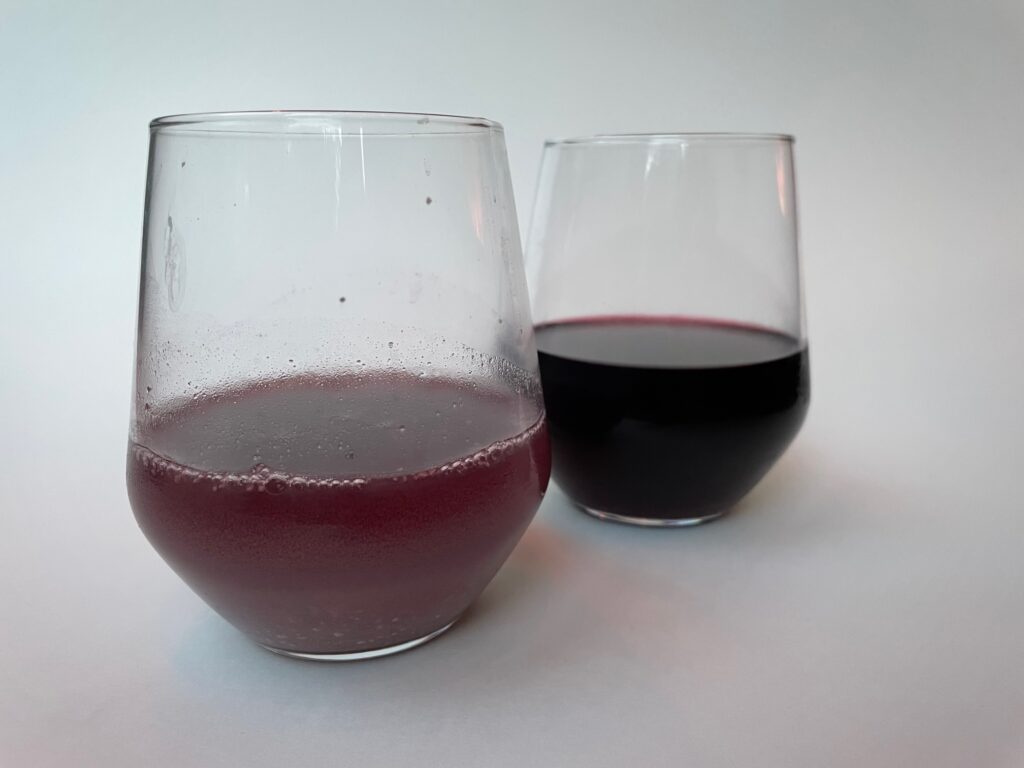
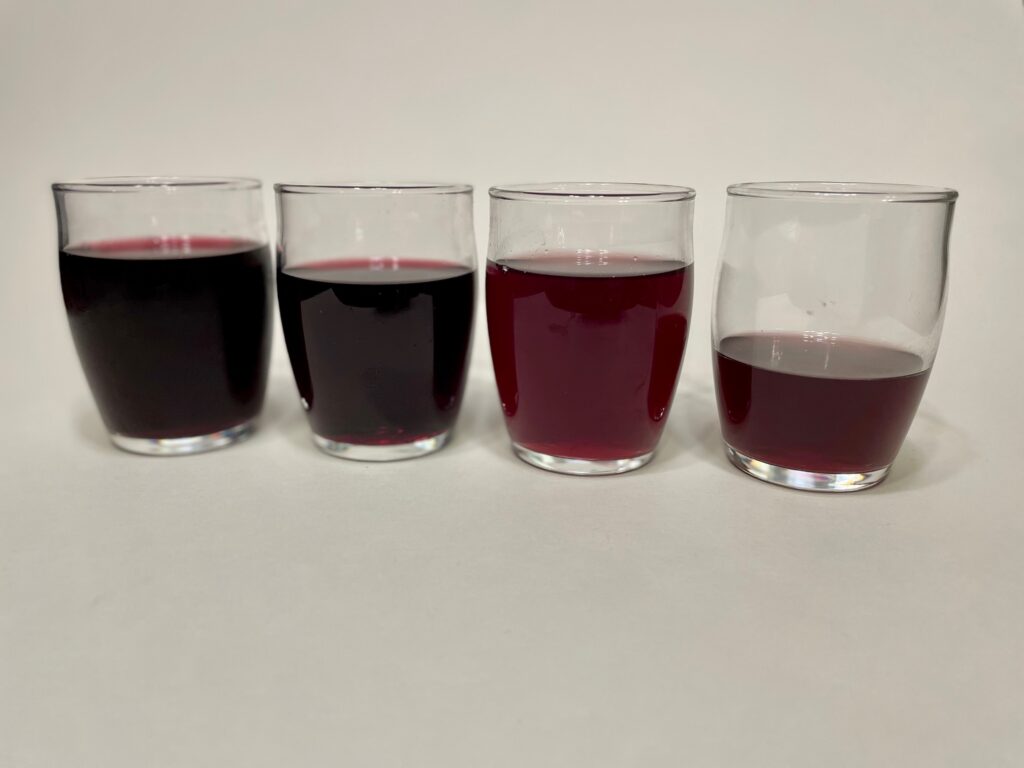
Figure 1 – Left – dried Fava beans; Center – unfiltered fava bean/wine with the fava bean meal making the wine an opaque mauve (foreground) and the wine as bottled (background); Right – first trial results.
For the first trial, I tried exposing 8 fluid ounces of wine to 2 weight ounces of fava bean meal. (I put dried fava beans in a coffee grinder on the coarse setting to create the meal.) The next morning, there was no appreciable change, so I both left it for an additional 24 hours and started a second experimental batch with 4 ounces of fava bean meal to 8 ounces of wine. At the end of the experimental period, I used a coffee filter to filter a sample of the unaltered wine and the two experimental wines so the effect of the filtering alone could be compared to any observed effect in the experimental samples. Figure 1, Right shows the relative loss of volume to the fava beans – the loss of fluid in the 4oz fava bean sample was considerable and I think would have been an unacceptable proportion. Samples of 10mL of the control wine, the filtered wine, the filtered 48hr/2oz fava bean experiment, and the filtered 24hr/4oz fava bean experiment were placed into glass shot glasses and photographed from above on a white background (see Figure 2 – Left, below).
The filtered wine actually was a little bit improved over the wine as bottled. It was slightly less astringent and tannic tasting with only the slightest lightening of color and improvement in clarity. Unfortunately, it cannot be said that the two experimental samples were an improvement. The 48hr/2oz fava bean experiment was visually the lightest of the samples, but tasted very strongly of fava beans, to the point of being barely drinkable. The 24hr/4oz fava bean experiment had less of a change in color and less of an odor and taste of the beans, but was still undrinkably beany and had a remarkable loss of volume. While there seemed to be some positive effect on the color of the wine in leaving it for a longer period of time, this also increased the bean flavor, even at a lower density of bean meal, so it does not seem practical to extend the experiment further. Also, while there was a definite lightening of the wine color and improvement in its clarity, the resultant wine could in no way be considered “clear” or “white.”
Obviously, this was disappointing, if expected, so I decided to have a closer look at the original recipe provided by Apicius. Upon reviewing the translated recipe directly, I found that it called for fava beans AND egg whites, not just the fava beans referenced by some of the prior redactors, so a second trial was called for.
For the first trial, I tried exposing 8 fluid ounces of wine to one half egg white, with and without 1 weight ounce of fava bean meal. After 24 hours, I filtered a sample of the unaltered wine and the two experimental wines so the effect of the filtering alone could be compared to any observed effect in the experimental samples. Volume loss in each sample was minimal. Samples of 10mL of the control wine, the filtered wine, the filtered 24hr/half egg white experiment, and the filtered 24hr/half egg white/1 oz fava bean experiment were placed into glass shot glasses and photographed from above on a white background (see below, right).
Again, the filtered wine was slightly improved over the wine as bottled. The first experimental sample – one half egg white per 8oz of wine – had a perceptible change in the color of the wine, being a few shades lighter, but no real change in the clarity of the wine. The second experimental sample – one half egg white and 1oz of fava bean meal per 8oz of wine – was only the slightest bit lighter than the egg white only sample and had a similar level of clarity. Unfortunately, even the smaller amount of fava bean meal imparted enough of a beany flavor that the bean/egg sample was unpleasant to drink. The egg white only sample, however, was actually a slight improvement on both the wine as bottled and the filtered wine. The egg white, while only slightly changing the color of the wine, did impart a “rounder” mouth feel to the wine and made the fruity/jammy flavors more pronounced while further suppressing the tannic flavors. The egg white only sample still could not be called “clear” or “white,” but it was not unpleasant to drink and the whole sample was willingly consumed by the taste-testers.
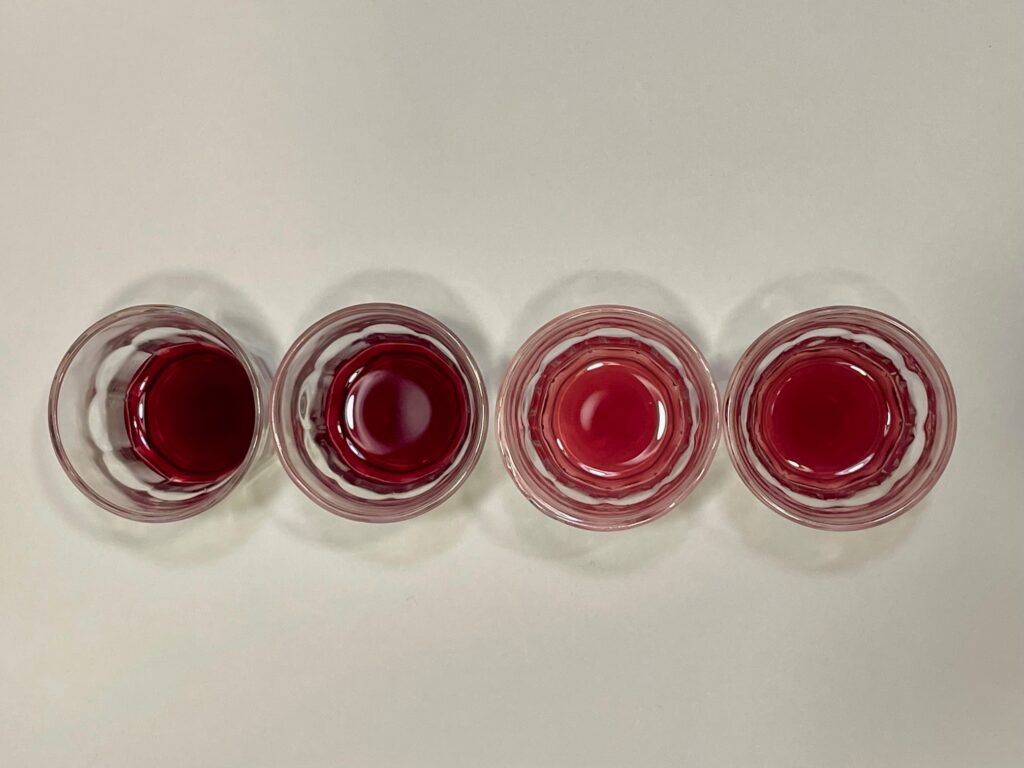

Figure 2 – Left: First trial (left to right) – control wine as bottled, filtered unaltered wine, filtered wine exposed to 2 ounces of fava bean meal for 48 hours, filtered wine exposed to 4 ounces of fava bean meal for 24 hours. Right: Second trial (left to right) – control wine as bottled, filtered unaltered wine, filtered wine exposed to 1/2 egg white for 24 hours, filtered wine exposed to 1 ounce of fava bean meal and 1/2 egg white for 24 hours.
The recipe in Apicius does specify that this is to clarify a “muddy” wine, so I wonder if previous interpretations have been mistaken in their belief that this should result in a completely clear – as in white – wine. Perhaps the intent is to only “clear” sediments from wines with impurities or suspended particles from an inexpert pressing of the grapes.
A fuller write-up of this failed experiment was entered into the 2024 Northshield Arts and Sciences Competition as a Fail&S. I hope to find an actual “muddy wine” at some point to re-trial this. If you know a bad vintner or someone with a poor batch of wine, please send them to me. In the mean time, the white wine serves at our thermopolium is made and purchased as a white wine.
Clothing
As we were depicting employees of a street food stand, we all tried to dress in simple, relatively low status Roman clothing. For the women, this was simple tube dresses pinned on either side of the neck. The collaborators took inspiration from a variety of frescoes – a servant girl lurking to the back and side of a couple dining practically nude (left), a tavern girl serving beverages (center, full image here), and another server at a tavern (right, full image here).
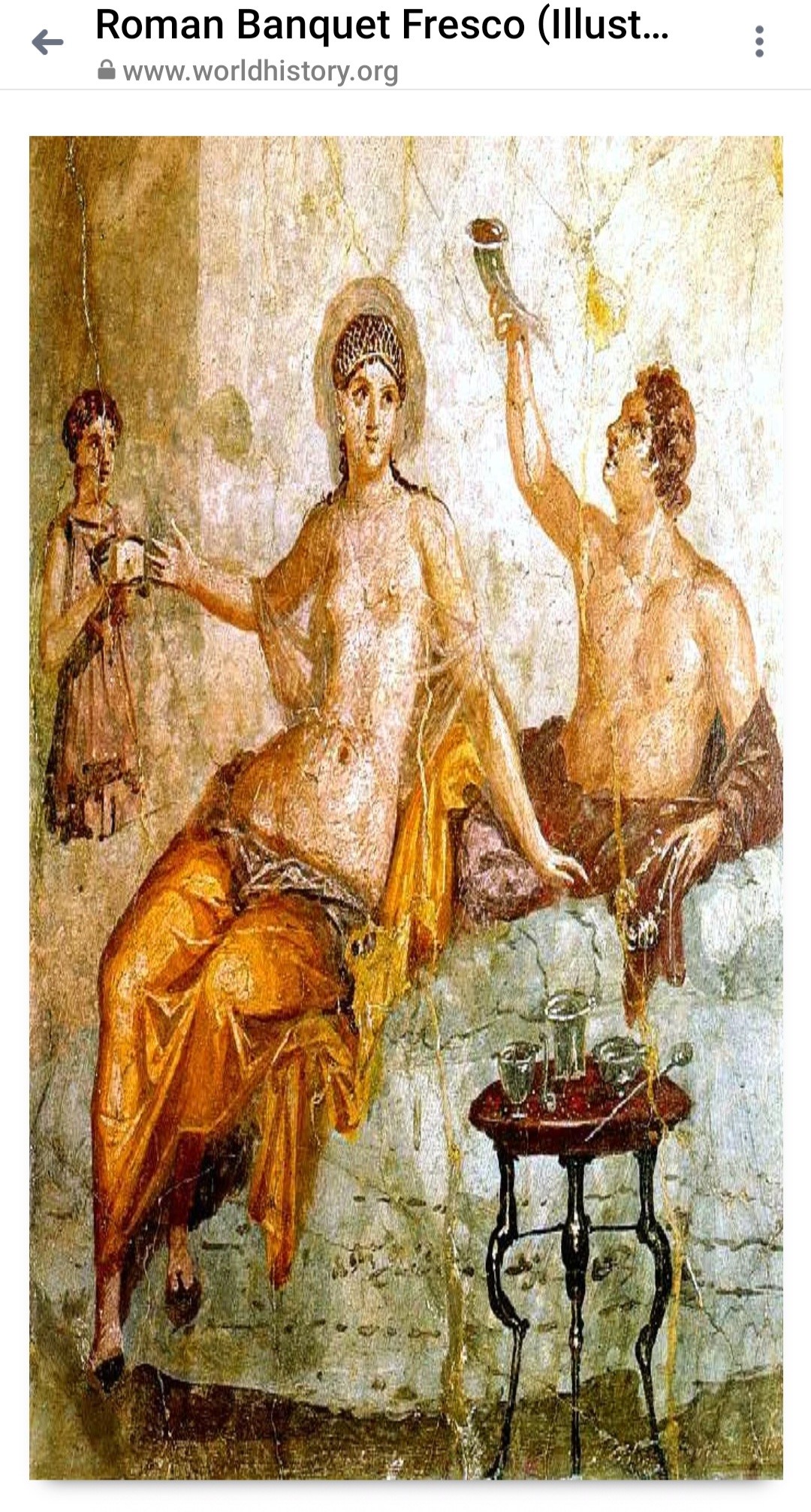
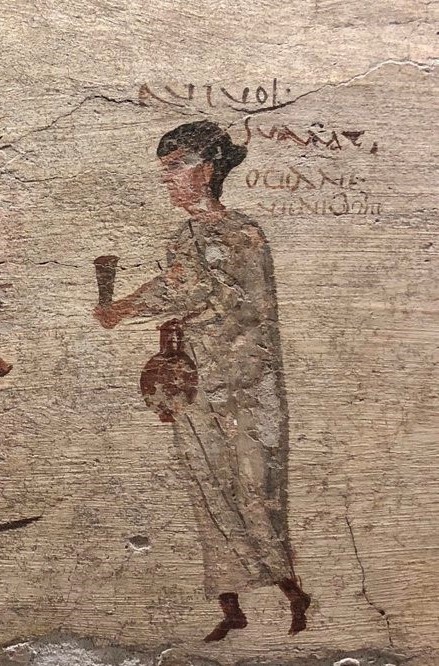
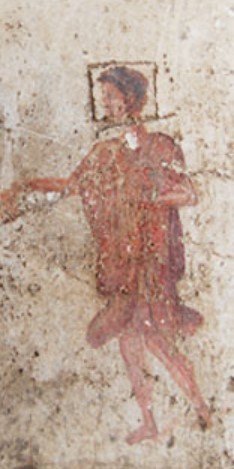
The Thermopolium Recreated
We decided to name our thermopolium Vesta’s since Vesta is the Roman goddess of the hearth and home and we wanted to offer a warm and welcoming bite to eat. It also conveniently allowed us to make a funny logo that riffs off a familiar modern fast food joint. The “illuminated” sign was made on a piece of rawhide and painted with food dyes to allow the light to pass through. It was lit from behind with a thoroughly modern LED light diffused by wool roving. (The final sign got a black border to prevent the light leak around the edges – the rawhide got a little wobbly from the dye application.)
We chose a location across the street from where court and the torchlight tourney would be held so we would have good visibility and traffic flow. We had to haul water but had access to power, which was necessary for the electric “dolia.” The thermopolium was constructed during the afternoon and then covered with canvas until the big reveal at the end of court.
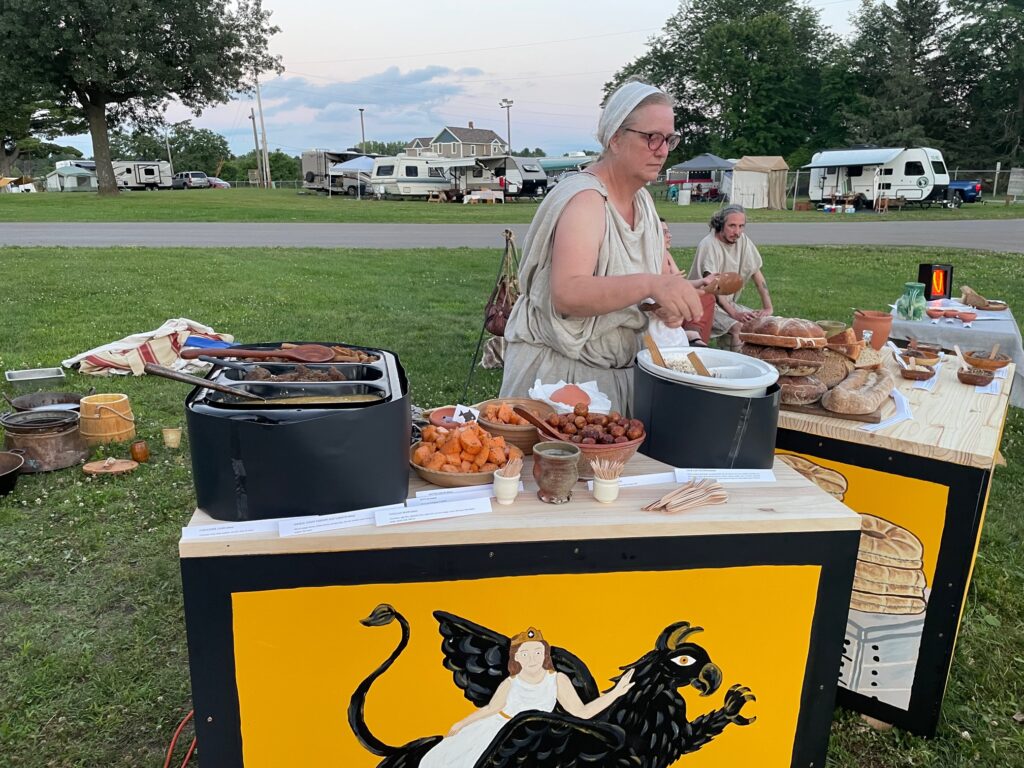
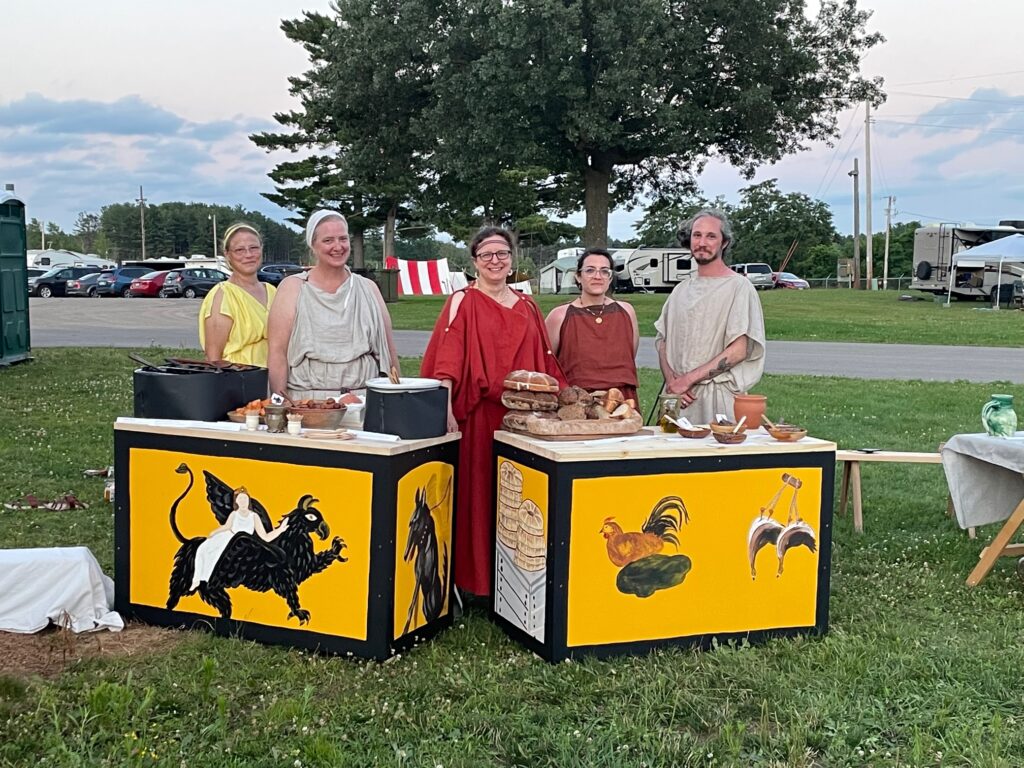
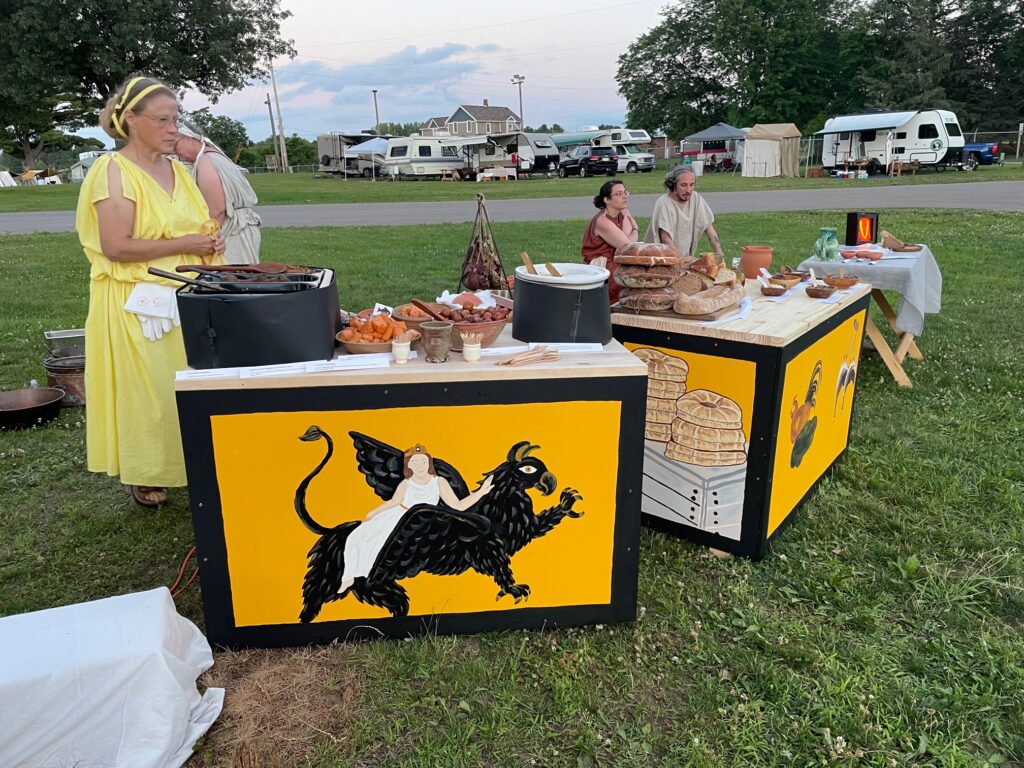
For food safety reasons, we used modern Nescos and Crock Pots to keep the food safely warm. We had originally planned on a concealed space for the pots with holes at the top to approximate the round openings of the Pompeiian thermopolium’s dolia, but that ended up not being feasible and we just wrapped them in black paper to make them slightly less obtrusive. Our other attempt at increasing food safety was that each dish was labeled with the name and ingredients and the dishes that contained fish or rue were tagged with small signs to alert potentially affected people.
To serve the foods while creating minimal waste, round roti (which approximate Roman wheat flat breads) were cut into quarters and placed on a napkin. The samples were then served on the roti “plate.” The Globis and the minted melon were simply served with a toothpick. We had bamboo spoons available, but they were generally not needed.
Overall, the food was received very favorably with many gasps of surprise and delight. The root vegetables paired very nicely with the lamb and the fava beans were a hearty option for vegetarians tolerate of a fish sauce. The duck was also wildly popular, “outselling” the chicken in the same sauce, probably because of the novelty of the duck rather than any real difference in deliciousness.
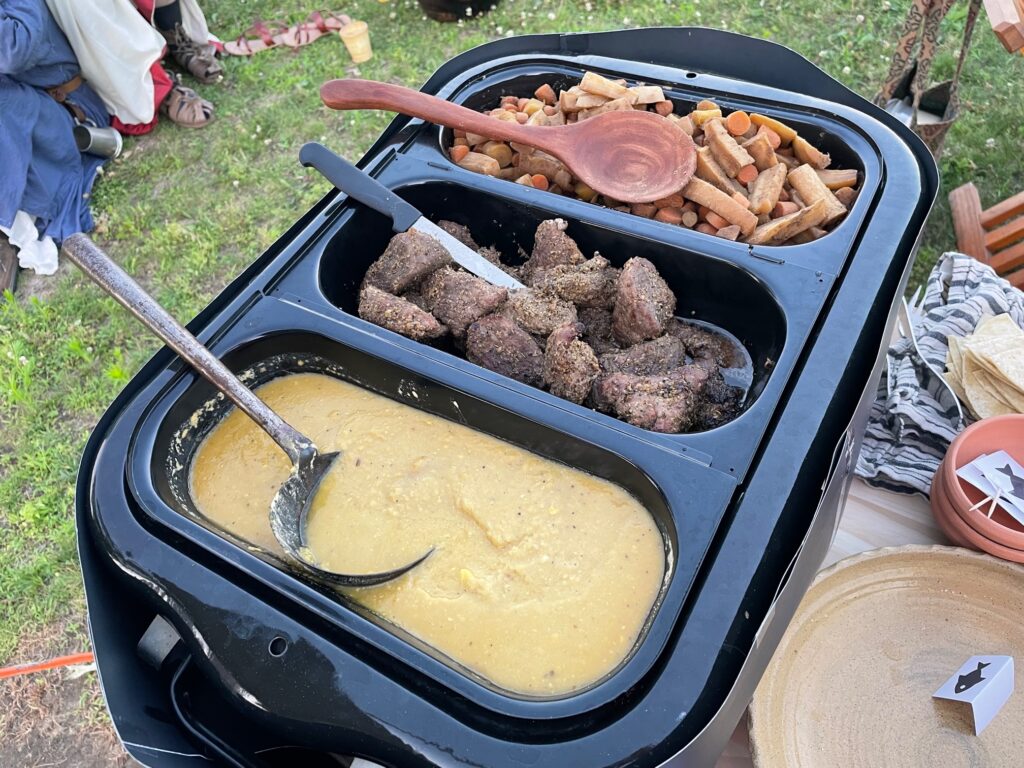
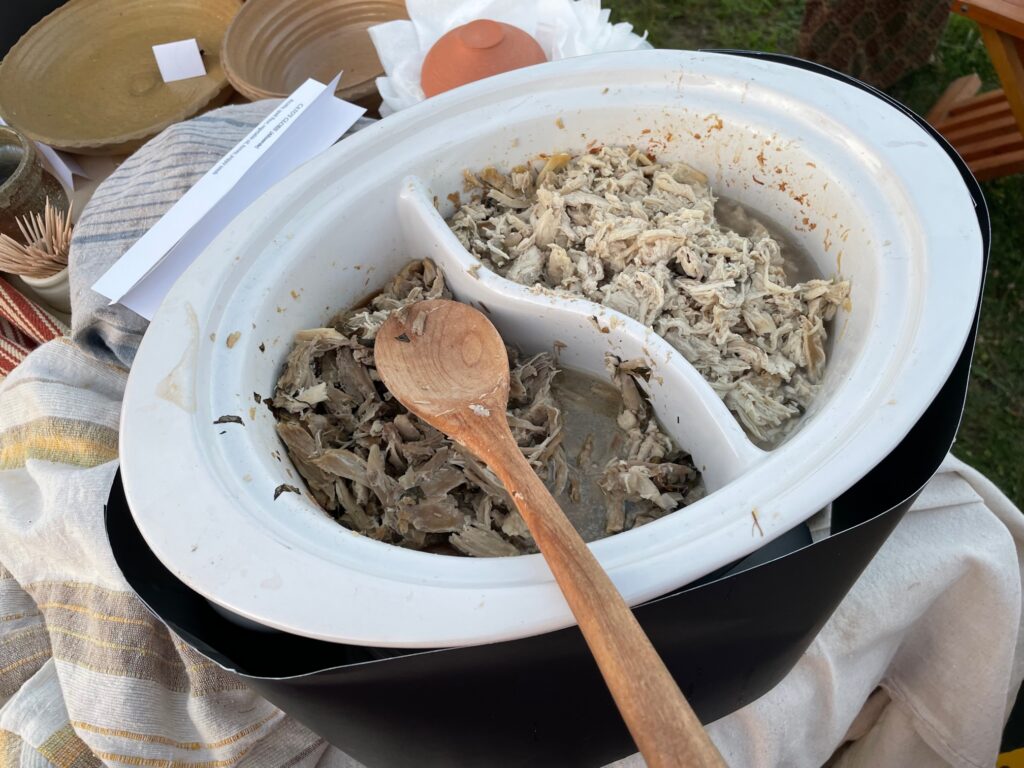
The honey-coated Cato’s Globis were far and away the fan favorite, but it is hard to beat deep fried cheese soaked in honey and poppyseed, so it was no great surprise that those were the first item to disappear off the menu. The minted melon was a surprise dish for many people – we offered both the recipe as provided and a version made without the fish sauce. While people agreed that fish sauce on fruit sounded strange and unappetizing, those who tried it were surprised at how well it worked and those who compared the two versions agreed that the fish sauce version was a more complex, more pleasing version.

Foreground: Cato’s Globis (Alissende)
Bread is ever-popular and a easy entry point for anyone who might have reservations about “weird period food,” so we were pleased to offer a nice variety of options for people to try. They also provided a convenient vehicle for sampling Sol’s sauces. Somewhat surprisingly, the heavily seeded loaf was the most popular of the options but the grape must bread garnered a lot of questions about collecting the wild yeast.

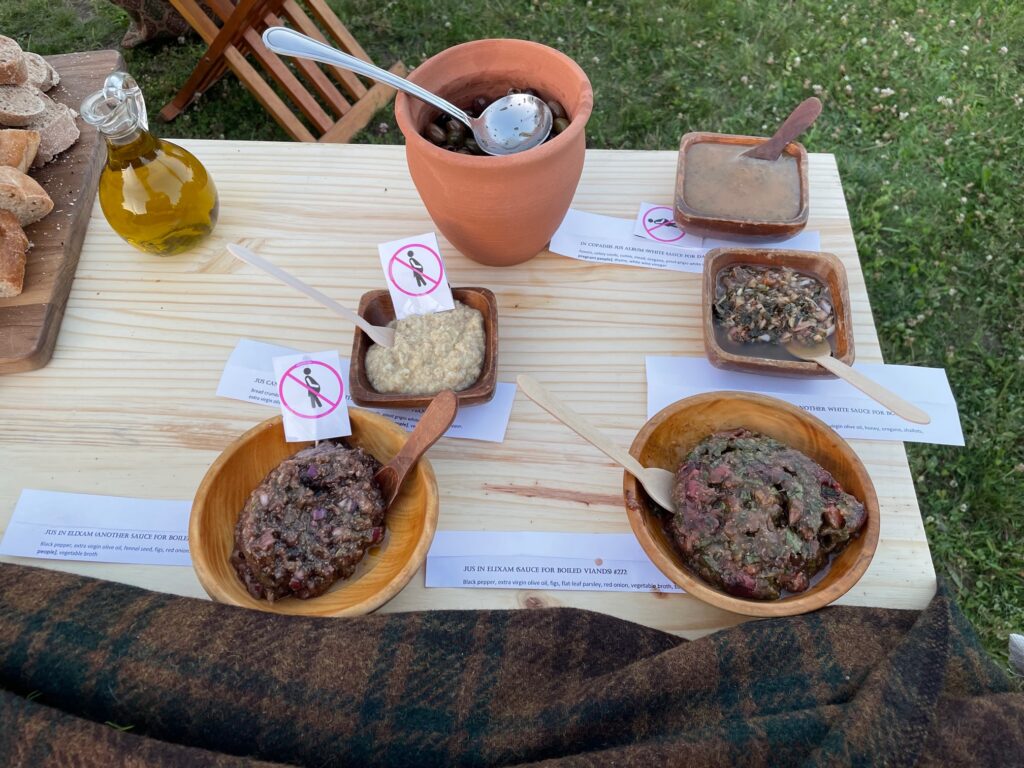
Our last station was the beverage stand, where the white and red wines (purchased) and the posca were offered. The real star of the show here was Farolfus’ small cups. He threw a few dozen of nearly identical bowls for serving the wine and the runnier dishes. On the same table we displayed a binder of our documentation and, under the illuminated sign, a menu alongside a sampler platter of all the dishes being offered.
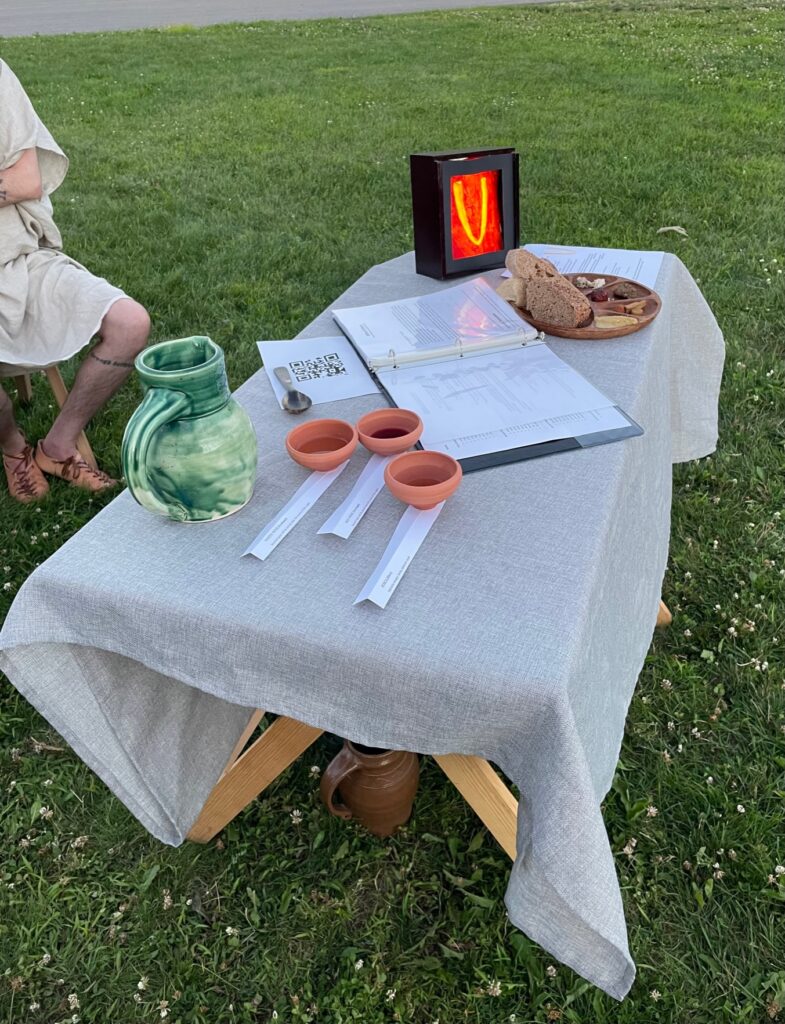

Our location provided a steady but not overwhelming flow of “customers” from when we opened after court through the end of the torchlight tourney.
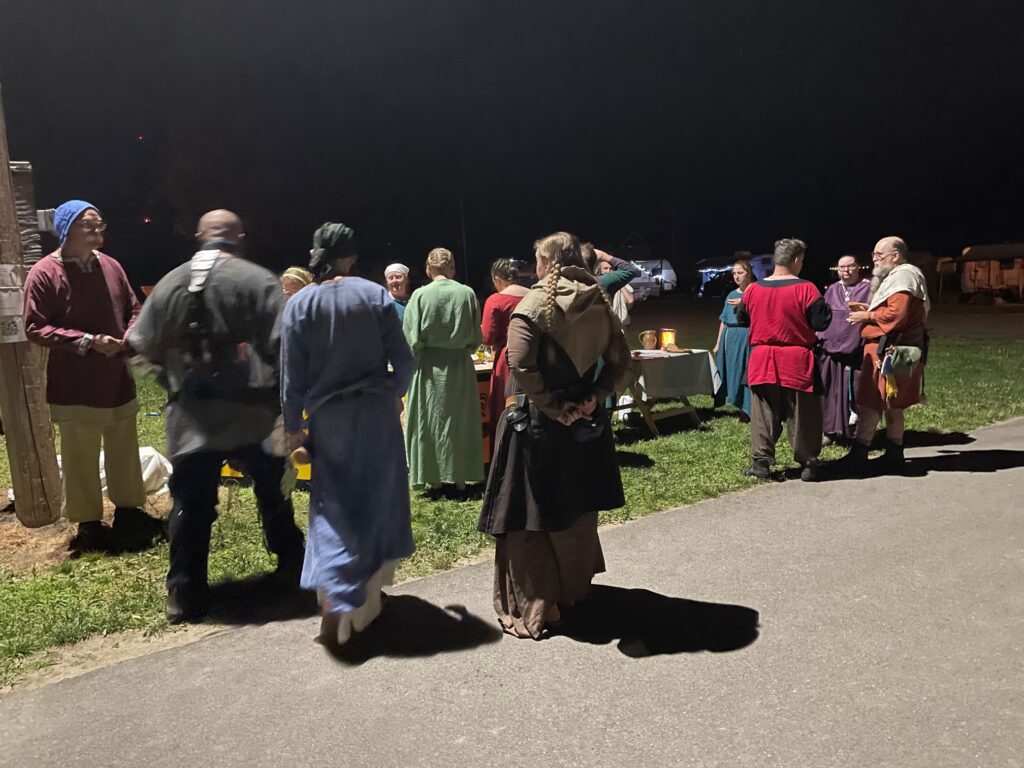
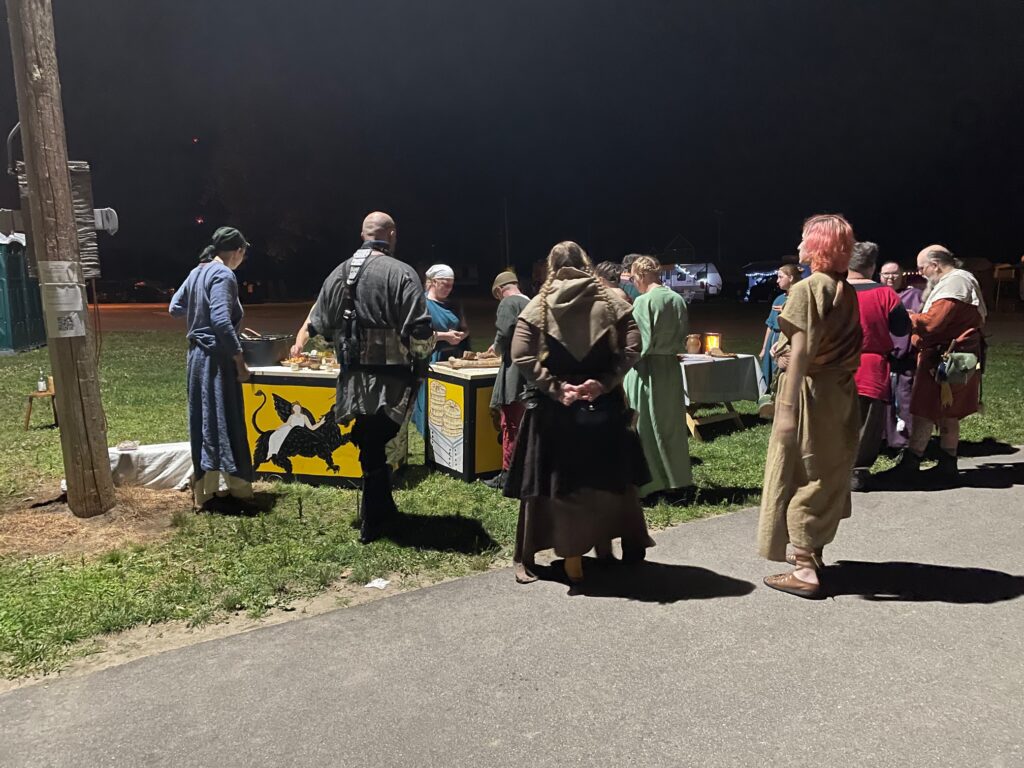
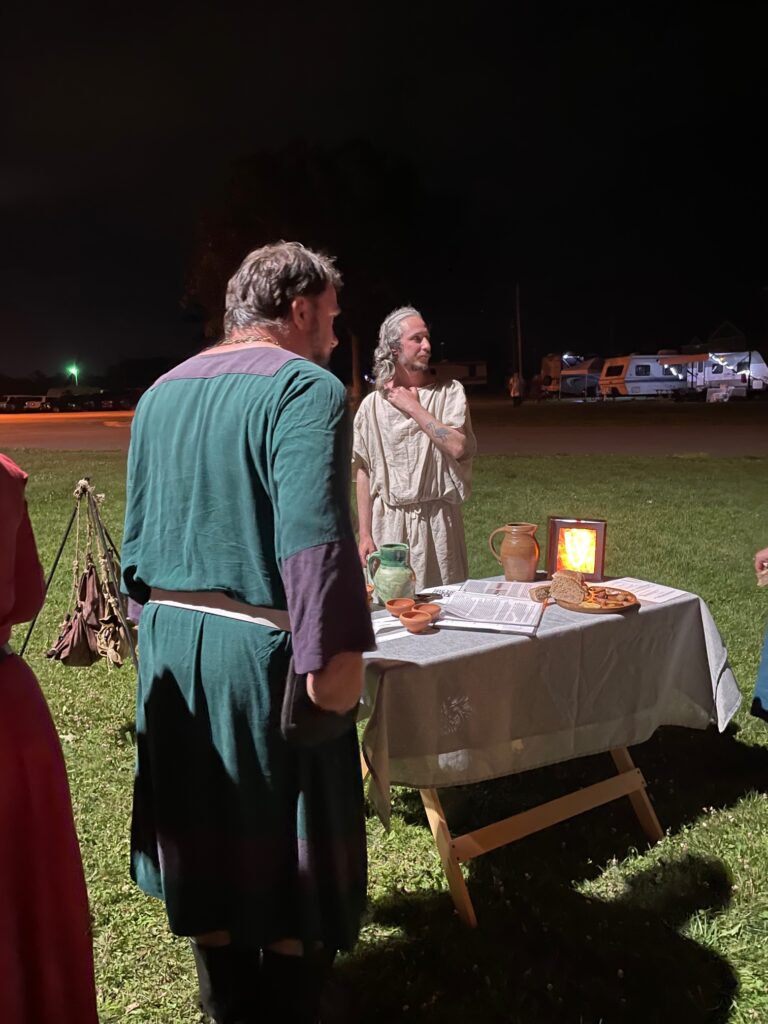
To simplify the serving process and the rules and regulations around serving food and beverages, all materials were donated by the collaborators and no money was collected from the populace. For the alcoholic drinks, we did card anyone not known to the servers to be over 21 years old, but otherwise, all interested gentles were served any or all of the dishes on the menu.
Collaborators
- Alissende de Montfaucon (Tammy Thompson) – Food (Chicken, Duck, and Cato’s Globis), Painting (Ducks and Chicken), Serving
- Bridei, alleged to be Countess Northshield (Lorece Aitken)- Painting (Bread), Serving
- Çida Sol – Food (Sauces)
- Eithni ingen Talorgain (Jean Kveberg) – Painting (Griffon and Lady, Posca, Amphorae, details on Bread), Food (Bread, Posca, Carrots, Lamb, Fava Beans), Serving
- Farolfus filius Richardi (Sebastian Renfield) – Pottery, Wineskins, Serving
- Hrothgar Ulf Gunnarsson, called Gar (Chris Moyer) – Structure Construction and Set Up, Painting (guard dog)
- Messiena Marcella (Grace Ludwig)- Food (Must Bread, Trieme Bread), Serving
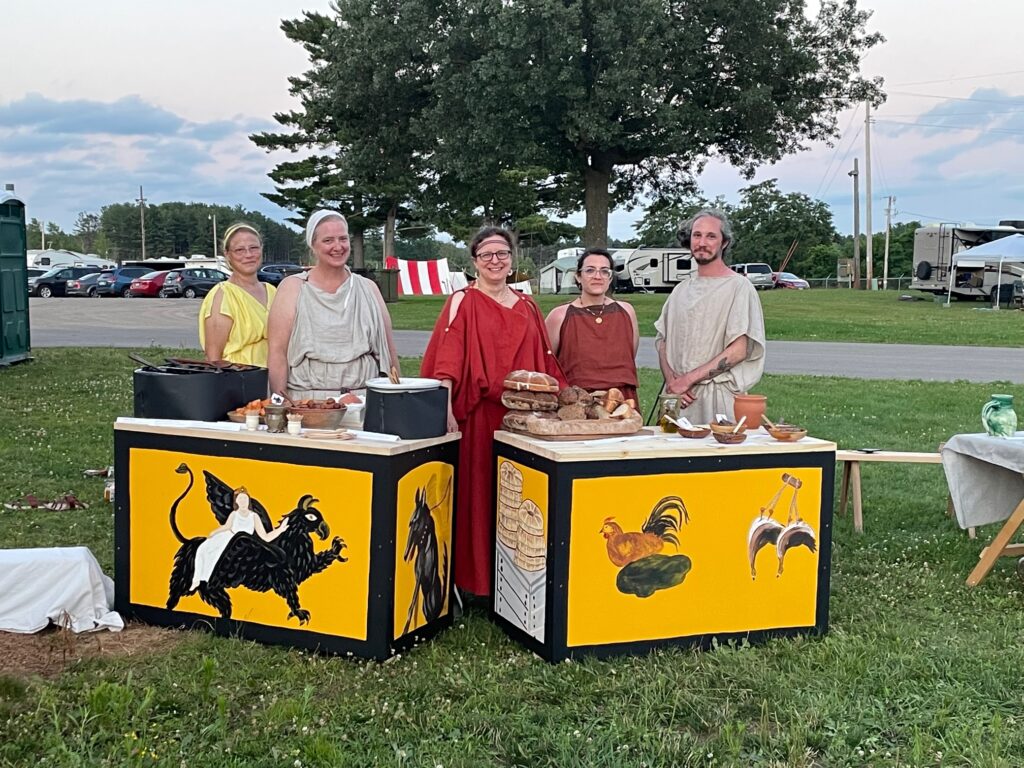
(Not Pictured: Sol and Gar)
A Word from Eithni:
My greatest appreciation and gratitude to all of my co-collaborators. From a crazy idea in a tangentially related Facebook thread to this amazing completed project, thank you for coming along with me on this adventure! It was an honor and a joy to take this deep dive with you into a new topic, feeding off of each other’s discoveries and and excitement as we learned together. Thank you all!
Special thanks to:
- Their Royal Majesties, Ajax and Gaia, for inspiring this madness
- The site stewards of Warriors and Warlords who allowed us to present this project as a fun SEEKRIT PROJEKT
- Æðelwald Bald (Denis Zdanovsky) for being a willing-enough taste-tester, even for the very strange recipes and experiments
- Asny Grimmsdottir (Anna Hunter) for being our dishwasher and otherwise indispensable help
- Itta (Laura) for being a willing helper in a dozen little ways
Citations and Sources
A note on Apicius – His “De Re Coquinaria” is a standard Roman food source and was used in various editions and translations for this project. In addition to the direct translations, many of the other sources often used his work but provided more redaction or interpretation.
“A 15th Century Trestle Table from Bruges.” St. Thomas guild – medieval woodworking, furniture and other crafts. Accessed July 10, 2022. https://thomasguild.blogspot.com/2012/07/a-15th-century-trestle-table-from-bruges.html.
Apicius, and Joseph Dommers Vehling. Apicius, Cookery and Dining in Imperial Rome: A Bibliography, Critical Review and Translation of the Ancient Book Known as ‘Apicius De Re Coquinaria’. New York: Dover Publications, 1977. https://penelope.uchicago.edu/Thayer/E/Roman/Texts/Apicius/home.html
Apicius, and Joseph Dommers Vehling. Apicius: A Critical Edition with an Introduction and English Translation. New York: Prospect Books, 2006.
Bond, Sarah E. “At the Copa: Women, Clothing, and Color Codes in Roman TavernsSarah.” History From Below. History From Below, April 9, 2021. https://sarahemilybond.com/2021/04/08/at-the-copa-women-clothing-and-color-codes-in-roman-taverns/amp/.
Cato, Marcus Porcius, and Andrew Dalby. Cato on Farming: A Modern Translation = De Agricultura. Totnes: Prospect, 1998.
Also available online at http://penelope.uchicago.edu/Thayer/E/Roman/Texts/Cato/De_Agricultura/home.html
Grainger, Sally. Cooking Apicius: Roman Recipes for Today. Totnes: Prospect Books, 2006.
Johnson, Melissa. “Panis Quadratus: Ancient Bread of Pompeii.” Breadtopia, December 23, 2021. https://breadtopia.com/panis-quadratus-ancient-bread-of-pompeii/.
Miller, Max. “Feeding a Roman Legion | Posca & Laridum.” YouTube. Tasting History, April 13, 2021. https://www.youtube.com/watch?v=qj5vg2fjOtk.
Miller, Max. “Taste Ancient Roman History with Globi (Cheesecake Bites).” Rachael Ray Show. Rachael Ray Show/Tasting History, June 1, 2021. https://www.rachaelrayshow.com/recipes/ancient-roman-globi-recipe-tasting-history-with-max-miller.
Miller, Max. “The Bread of Ancient Rome | Pompeii’s Panis Quadratus.” YouTube. Tasting History, July 14, 2020. https://www.youtube.com/watch?v=Sw2qrt6tOKw.
Monaco, Farrell. “Baking with the Greeks: Demeter’s Daughter.” Tavola Mediterranea, July 11, 2021. https://tavolamediterranea.com/2019/09/12/kore-bread/.
Monaco, Farrell. “The Mediterranean Triad – Grapes, Grains and Olives: Death by Defrutum.” Tavola Mediterranea, February 21, 2021. https://tavolamediterranea.com/2018/05/17/mediterranean-triad-grapes-grains-olives-defrutum/.
Monaco, Farrell. “The Roman Sweet Tooth: Cato’s Globi.” Tavola Mediterranea, July 13, 2021. https://tavolamediterranea.com/2017/10/05/roman-sweet-tooth-cato-globi/.
Monaco, Farrell. “Tracta Et Fabam Vitellianam (Vitellian Beans with Farro Rusks).” Tavola Mediterranea, March 5, 2018. https://tavolamediterranea.com/2017/09/14/olive-oil-empire-tracta-pisam-vitellianam/.
Peña, J. Theodore, and Myles McCallum. “The Production and Distribution of Pottery at Pompeii: A Review of the Evidence; Part 1, Production.” American Journal of Archaeology 113, no. 1 (2009): 57–79. https://doi.org/10.3764/aja.113.1.57.
Peña, J. Theodore, and Myles McCallum. “The Production and Distribution of Pottery at Pompeii: A Review of the Evidence; Part 2, the Material Basis for Production and Distribution.” American Journal of Archaeology 113, no. 2 (2009): 165–201. https://doi.org/10.3764/aja.113.2.165.
Roman Posca. Vita Romae. Accessed July 1, 2022. https://www.vita-romae.com/roman-posca.html.
Schwarz, Christopher, and Christopher Schwarz Chris is the former editor of Popular Woodworking Magazine. He continues to blog and publish woodworking books at Lost Art Press. He’s a hand-tool enthusiast (though he uses power tools. “The First Trestle Tables.” Popular Woodworking. Popular Woodworking, January 11, 2021. https://www.popularwoodworking.com/article/the-first-trestle-tables/.
“The Snack Bar of Regio V Resurfaces in Its Entirety with Scenes of Still Life, Food Residues, Animal Bones and Victims of the Eruption.” Pompeii Sites. Archaeological Park of Pompeii, December 29, 2020. http://pompeiisites.org/en/comunicati/the-ancient-snack-bar-of-regio-v-resurfaces-in-its-entirety-with-scenes-of-still-life-food-residues-animal-bones-and-victims-of-the-eruption.
Trestle tables. Accessed July 10, 2022. http://www.larsdatter.com/tables.htm.
